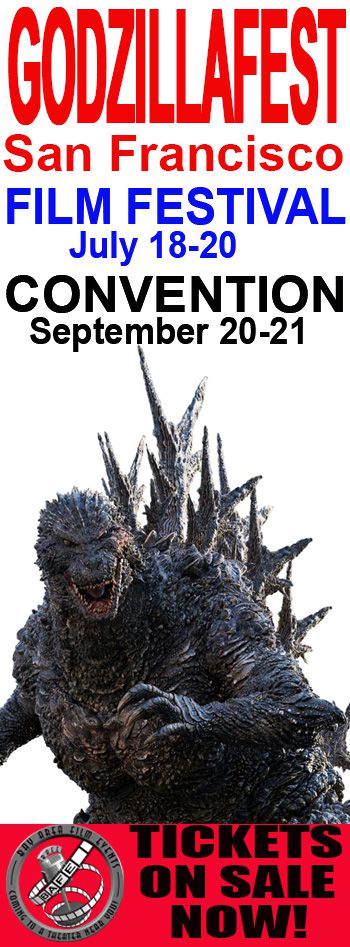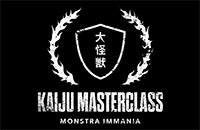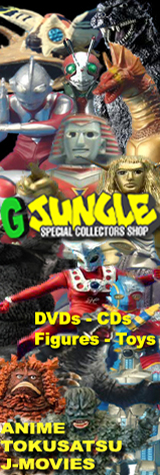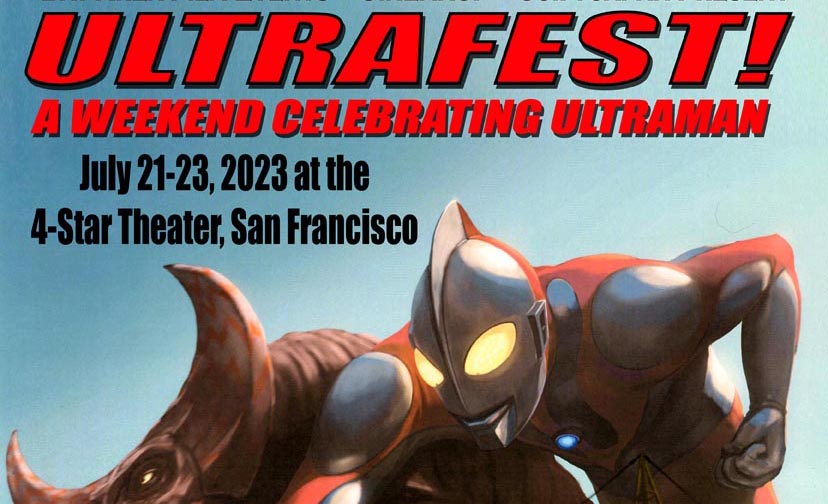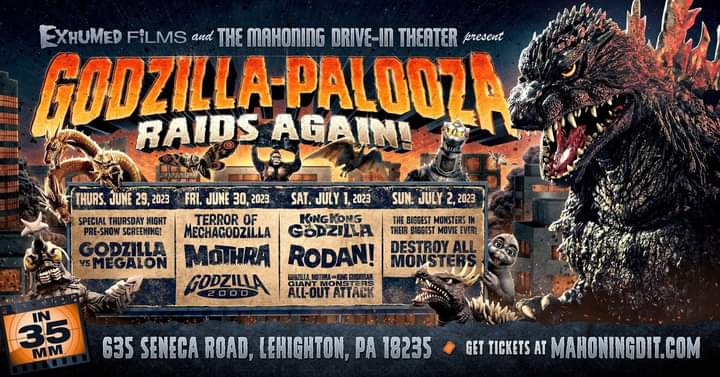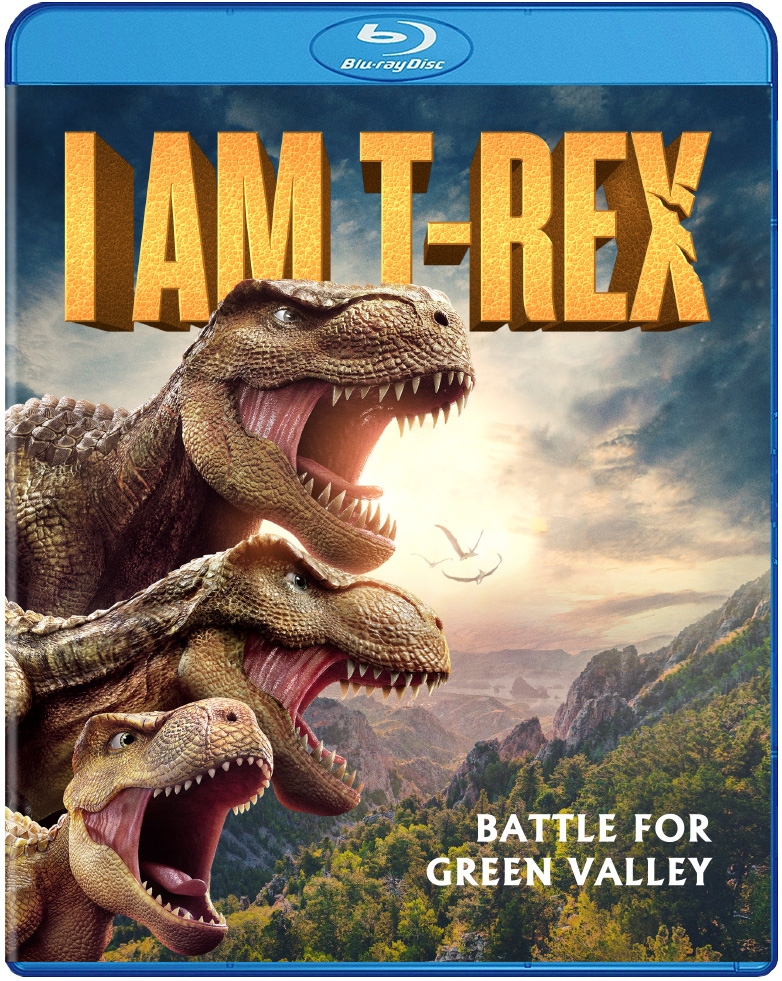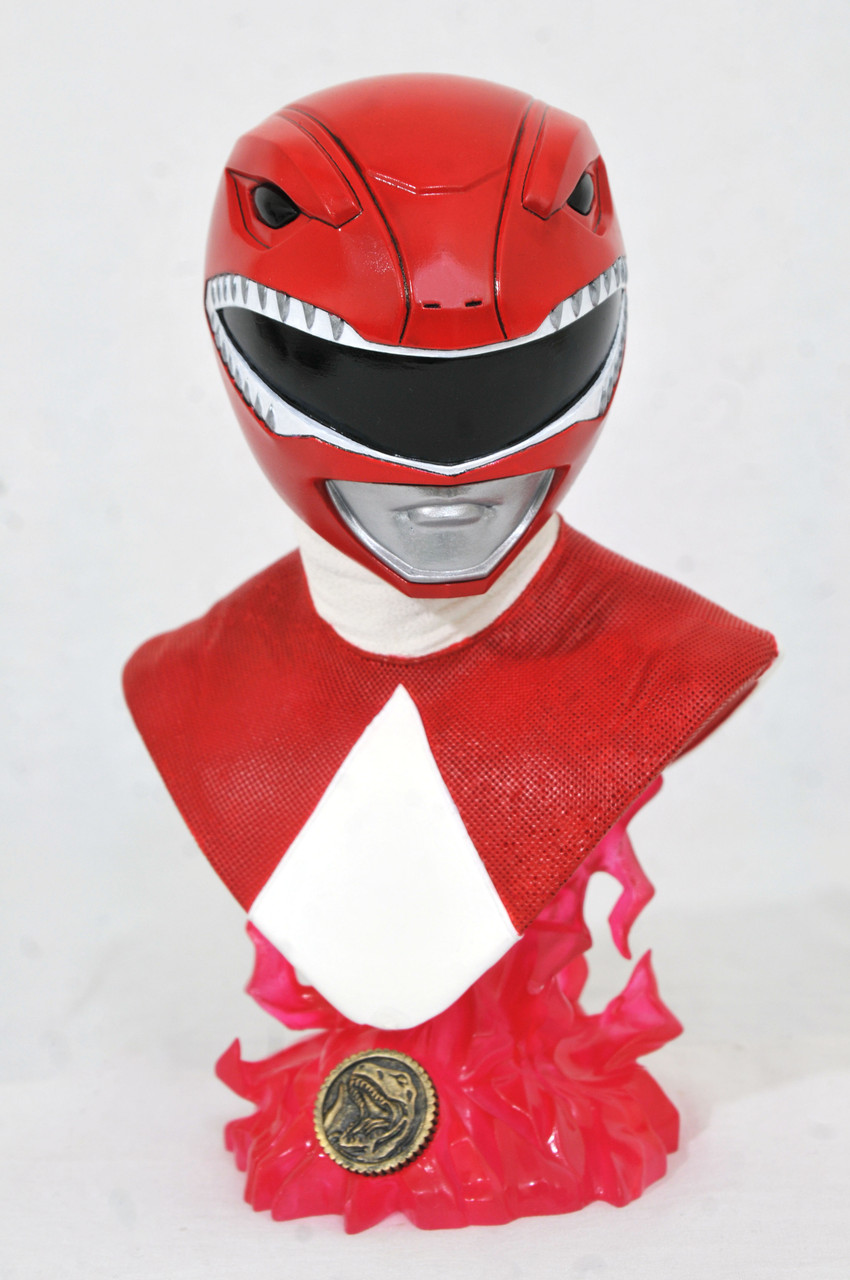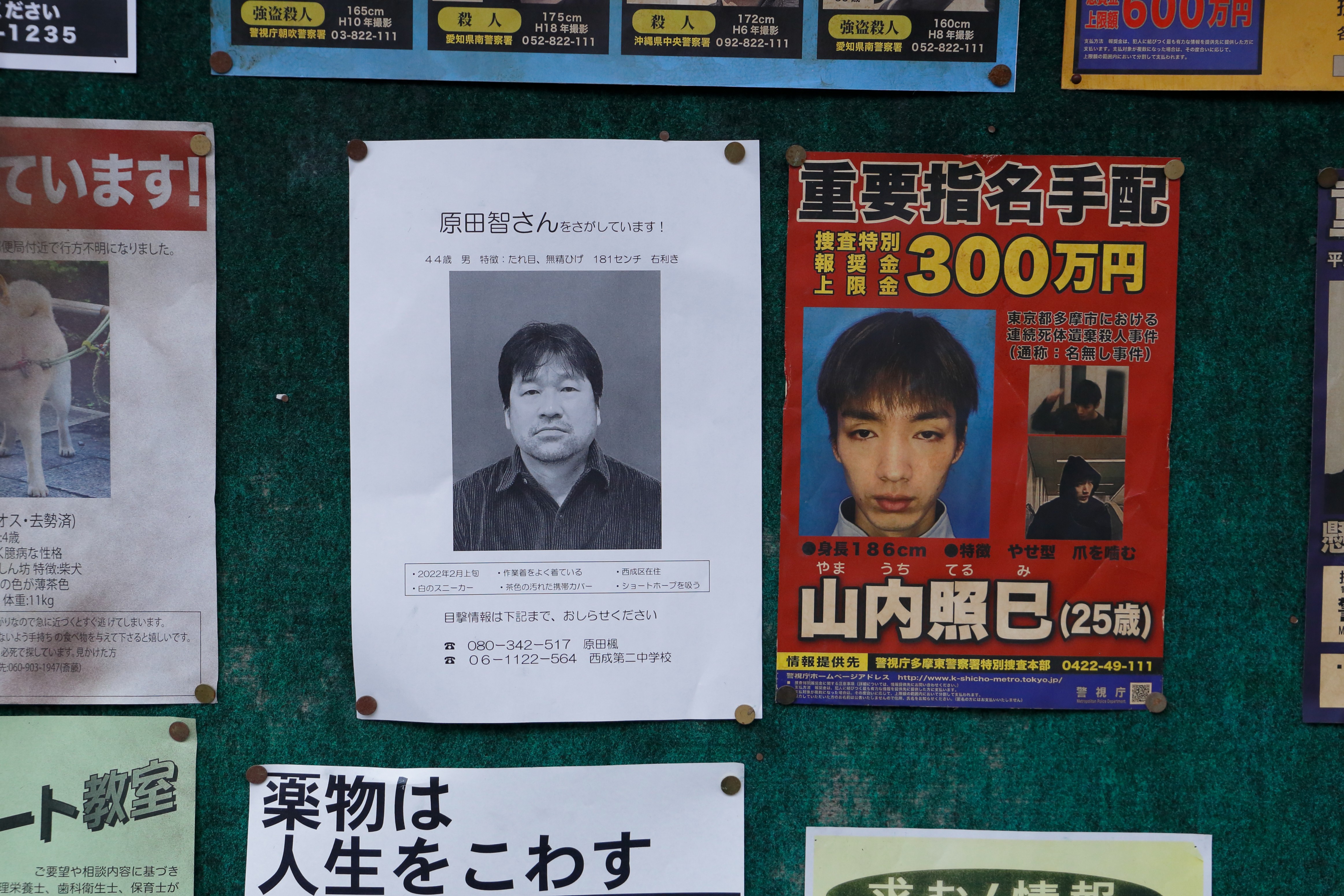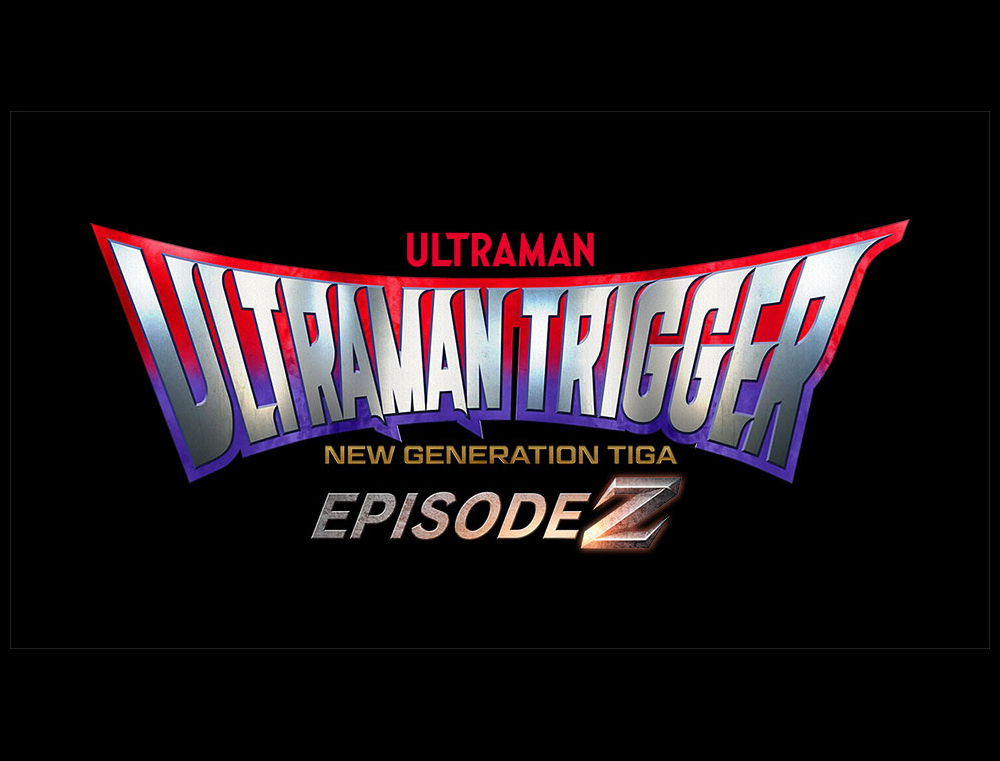ULTRAMAN: THE ADVENTURE BEGINS (aka ULTRAMAN USA) American Version: ULTRAMAN: THE ADVENTURE BEGINS Release Date: October 9, 1987 Running Time: 80 minutes Aspect Ratio: 1.33:1 Distributor: Hanna-Barbera
Japanese Version: ULTRAMAN USA Japanese Title: ??????USA (Urutoraman USA) Literal Translation: Ultraman USA Release Date: April 28, 1989 Running Time: 80 minutes Aspect Ratio: 1.66:1 (Vista) Distributor: Toho Co., Ltd. Production: Tsuburaya Productions, Hanna-Barbera, Kodansha, Nihon Columbia, Bandai Animation Production: Ashi Productions Executive Producer: William Hanna, Joseph Barbera, Noboru Tsuburaya Director: Mitsuo Kusakabe Supervising Director: Ray Patterson Associate Director: Hiroshi Negishi, Toshitarou Ohba Key Animation: Kazuo Iimura Original Story: Noboru Tsuburaya Writer: John Eric Seward Voice Director: Gordon Hunt Casting Director: Andrea Romano Talent Coordinator: Kris Zimmerman Music: Shinsuke Kazato "Ultraman" Theme: Shunichi Tokura
US Voice Cast Scott Masterson/Ultraman Scott: Michael Lembeck Chuck Gavin/Ultraman Chuck: Chad Everett Beth O`Brien/Ultrawoman Beth: Adrienne Barbeau Walter Freeman: Stacy Keach Sr. Dr. Susan Rand: Lorna Patterson Andy: Charley Adler David Hall Ed Gilbert Adrienne Alexander Ronald Schell Les Tremayne Japanese Voice Cast Scott Masterson/Ultraman Scott: Tohru Furuya Chuck Gavin/Ultraman Chuck: Shinji Ogawa Beth O`Brien/Ultrawoman Beth: Hiromi Tsuru Walter Freeman: Kouhei Miyauchi Dr. Susan Rand: Rihoko Yoshida Andy: Kyoko Yamada Samson: Hiroshi Ootake Ulysses: Isamu Tanonaka Dr. Filby: Yasuo Tanaka General Cooper: Takeshi Aono Colonel Bodinga: Masaharu Satou Mark: Kaneto Shiozawa
Story: Pieces of a strange comet fall to Earth, crashing at locations across America. Days later, Captain Scott Masterson, Captain Chuck Gavin, and Lieutenant Beth O`Brien -- ace stunt pilots in the Los Angeles-based “Flying Angels” team -- are suddenly engulfed in a mysterious light during a flight. Shockingly, all three survive the incident without injury.
Ordered to take some time off by their commanding officer General Cooper, the three pilots enjoy the day at a golf club in Pebble Beach. They are approached by Walter Freeman, an elderly groundskeeper who leads the three to a super modern secret base beneath the golf course. Walter informs them that he is secretly an undercover agent for an intergalactic police force, and explains the truth behind their encounter with the strange light: they are now the host bodies for the Ultra Force, alien beings from the planet Altara in M78. The Ultra beings have come to Earth to defend it from four monsters from the planet Sorkin. After the destruction of their homeworld, the beasts arrived on Earth in fragments that crashed in Louisiana, California, Colorado, and New Mexico. "In other words, you have become Ultra warriors who will fight to save the world!" Led by Ultra Force Commander Walter, the three pilots arrive at their main base inside Mount Rushmore. There to greet them are the "Robotrio USA", three robots who serve as a support team for the Ultra Force. The thin, nervous and effeminate golden Combot Model MF842 (nicknamed "Ulysses") takes care of armaments and is knowledgeable on laser weapons; the strong blue and gold Combot Model BA666 (Samson) is an expert in battle tactics; and the small, brainy red and gold Utiloid Model ZQ14582 (Andy) maintains the Ultra Force`s headquarters and Mother Base, the giant flying battleship which the team lovingly refers to as "Big Mama". Most of the systems on Mother Base are automatic, and only the Robotrio USA are capable of manually operating the ship. Mother Base often houses the three Ultra Jets; small, one man fighter jets with a top speed of Mach 7.3. The Ultra Jets were created as anti-monster aircraft and come equipped with two lasers and missiles.
The first Sorkin monster, the plant creature Greenshocks, appears outside New Orleans and the Ultra Force goes into action. Beth`s jet is caught in the monster`s tendrils and she transforms into an Ultrawoman. Greenshocks attacks with an acidic liquid secreted from the flower on its head, and its vines snap out with a fearsome whip attack. Even worse, Greenshocks` ability to rapidly regenerate allow it to survive Ultrawoman Beth`s attacks. The Ultrawoman finally carries the monster over the Gulf of Mexico and drops it into the ocean, where it begins to dissolved from the salt water in the Gulf. Beth finishes off Greenshocks with her water controlling power, the Ultra Spout. Next, Ultraman Scott faced off with the electromagnetic mecha monster Galbalard in San Francisco. After a long battle, Scott slammed the creature into Alcatraz Island, damaging its metal body. Galbalard`s armor cracked open, releasing its inner self... a spherical electric monster called Eem. Ultraman Scott was caught off guard by the monster`s change in appearance and plasma eye beam strikes, but the arriving Ultra Force base ship was able to deflect Eem`s energy blast and give Scott the opening he needed to destroy his opponent via his Granium Beam final attack. In addition to finding and defeating the Sorkin monsters, the Ultra Force also have to contend with Dr. Susan Rand, a scientist from the Space Biology Research Center. Rand heavily criticizes the Ultra Force for their use of violence to defeat each of the space monsters. The Ultra Force shows a different side when a new Sorkin monster called Zoon causes damage at a ski resort near Denver. The National Guard moves in to kill Zoon, but the creature flees from the attack rather than retaliate. Zoon has small wings and can awkwardly fly like an overweight kabuki beetle. After noticing that there were no evil intentions to the monster`s confused and random actions, Ultraman Chuck realizes Zoon is just a baby and comes to its rescue. Chuck uses his Space Bubble power to transport Zoon safely to Planet M11 in the Andromeda Galaxy.
The Ultra Force thought that peace had finally been attained, completely unaware they had yet to fact their greatest threat. Signs of life are detected in a comet fragment at the crash site in New Mexico and it is promptly sent to the Space Biology Research Center in New York City for study. From that small fragment is born an adorable little Sorkin monster named Wylon. Dr. Susan Rand is initially overjoyed, thinking she has another innocent creature like Zoon. But Wylon quickly evolves into a giant monster called King Maira and begins to wreak havoc on the city. Constantly growing and with the power of teleportation, King Maira rampaged in the streets. The military attacks the monster but their efforts proves useless against it. The three Ultra Warriors arrive to face the beast, but not even the energy weapons and physical attacks of the Ultra Force could stop him. King Maira`s use of teleportation proves overwhelming. It also began to evolve further, getting larger and more violent. As the battle rages, the Ultra Force`s energy starts to fade and their color timers began to flash on and off. If they fail, King Maira will be continue to grow until it destroys the world. Aboard the Ultra Force Mother Ship, the Robotrio USA and Susan Rand use a Neural Interphaser to limit King Maila`s ability to teleport. The Ultra Warriors are finally able to carry King Maira into space and throw him into the sun. Victorious at last, the Ultra Force decides to remain on Earth with Walter and the robots to protect the world from any future threats that may emerge.
Notes: The original ULTRAMAN had been a long-running syndication success in America. The follow up series ULTRA SEVEN was also shown in Hawaii in 1975 and nationwide on the TNT cable station in the mid-1990s. But, despite repeated attempts, Tsuburaya Productions had failed to get their other films and shows widely distributed in the United States and other English speaking territories. Breaking back into those markets was of key interest to Noboru Tsuburaya, and during his time as CEO of Tsuburaya Pro he made several attempts to produce English language Ultraman projects with companies outside Japan. Noboru initially focused on the United States with plans for two big budget feature films to be called ULTRAMAN: THE JUPITER EFFECT (1980) and ULTRAMAN: HERO FROM THE STARS (1981) but failed to make any headway with these co-productions (see the ULTRAMAN ZOFFY entry of Movie Guide Part 3 for more information on these two films). Years later, Tsuburaya Productions finally did succeed in producing the English language TV series ULTRAMAN: TOWARDS THE FUTURE (1990) with the South Australian Film Commission, and ULTRAMAN: THE ULTIMATE HERO (1993) with Major Havoc Entertainment in Los Angeles.
But the first of these "international" Ultraman projects to actually get off the ground was ULTRAMAN: THE ADVENTURE BEGINS, a co-production with Hanna-Barbera Productions, Inc., the studio behind such world famous cartoon properties as the Flintstones, the Jetsons, and Scooby Doo. In the United States, superheroes like Superman and Spider-Man were traditionally of human stature rather than giant-sized; so with an "American-esque" take on Ultraman Hanna-Barbera saw an opportunity to take a concept so familiar in Japan and present something new and fresh to American children. TPC had initially wanted to do a live action series, but Hanna-Barbera convinced them to instead go with an animated film that would re-introduce Ultraman to an American audience and act as a pilot to a potential series. The original story was conceived by Noboru Tsuburaya. Following a number of development meetings between the two companies in of May 1987, the script was completed by writer John Eric Seward and the monsters and character designs finalized by the artists. Key character designs were done by Kazuo Iimura (A DOG OF FLANDERS) and Floro Dery (the animated TRANSFORMERS show and TRANSFORMERS: THE MOVIE) with monster designs by Hirotsugu Murayama (KIRBY: RIGHT BACK AT YA!). The three heroes in the Ultra Force generally maintained the traditional look and abilities of Tsuburaya`s live action Ultramen. One key difference was that Chuck, Scott, and Beth did not use the usual transformation devices but automatically turned into Ultra Beings whenever they were in life-threatening situations.
Model designs were created by
Keita Amemiya, a longtime fan-favorite artist and filmmaker. Following ULTRAMAN: THE ADVENTURE BEGINS, Amemiya worked as a character designer for Toei hero shows such as MASKED RIDER BLACK-RX (Kamen Raidaa Burakku Aru Ekkusu, 1988) and MOBILE COP JIBAN (Kidou Keiji Jiban, 1989). In 1983, he established his own workshop Graphical Corporation Crowd Inc. to create and produce his own projects such as CYBER NINJA (Mirai Ninja, 1988), ZEIRAM (Zeiramu, 1991), MASKED RIDER ZO (Kamen Raidaa Zetto, 1993), MASKED RIDER J (Kamen Raidaa J, 1994), ZEIRAM 2 (Zeiramu 2, 1994), MECHANICAL VIOLATOR HAIKAIDER (Jinzo Ningen Hakaida, 1995), MOON OVER TAO: MAKARAGA (Tao-no Tsuki, 1997), IRON ARMOR MIKAZUKI (Tekkoki Mikazuki, 2000), GARO (2005), and GARO: RED REQUIEM (2010). With children intended as the primary audience for ULTRAMAN: THE ADVENTURE BEGINS, the story presents the main characters in a fairly simple and straightforward manner. Chuck Gavin is the leader of the Ultra Force, a 35 year old career military man who started from the bottom to become a top pilot. He is smart with a calm, capable demeanor that is well suited for command. Scott Masterson is 25, single, and popular with women. 26 year old Beth O`Brien is a brave, intelligent and beautiful pilot. She is quick with a wisecrack, which she uses to mask that she actually possesses very delicate nerves. Susan Rand is a cliched "all work, no play" professional type... a genius who graduated from college at the age of 18 with a focus on medical science, space biology and bio engineering. The 24 year old seemingly has no interest in men, until she meets Scott, that is. The members of the Robotrio USA are often used for comic relief; in an amusing touch, the initials for the robots` names spell "USA".
Hanna-Barbera had a stable of voice actors built up over decades of cartoon production, but for ULTRAMAN: THE ADVENTURE BEGINS they went a different route, hiring several established actors known for their onscreen work. The English language cast included Adrienne Barbeau (Ultrawoman Beth), who had starred in her then-husband John Carpenter`s hits THE FOG (1980) and ESCAPE FROM NEW YORK (1981), as well as George Romero and Stephen King`s CREEPSHOW (1982) and Wes Craven`s SWAMP THING (1982). On television she was part of the main cast of the hit MAUDE (1972) and a recurring performer on THE DREW CAREY SHOW, BATMAN: THE ANIMATED SERIES and HBO`s CARNIVALE (2003). Chad Everett (Ultraman Chuck) worked steadily in film and television for nearly 50 years. His long list of credits included MEDICAL CENTER, AIRPLANE II: THE SEQUEL (1982), PSYCHO (1998), and MULHOLLAND DRIVE (2001). Stacy Keach, Sr. (Walter Freeman) was a regular on GET SMART and a guest star in dozens of television series. Michael Lembeck (Ultraman Scott) was a cast member of the long-running sitcom ONE DAY AT A TIME and the children`s series THE KROFFT SUPERSHOW. He is now an Emmy Award-winning director whose credits include several episodes of FRIENDS and the feature film THE SANTA CLAUSE 2. Lembeck`s wife Lorna Patterson (Susan Rand) was in AIRPLANE (1980) and had the lead role in the TV series PRIVATE BENJAMIN.
ULTRAMAN: THE ADVENTURE BEGINS was syndicated to American television beginning October 9, 1987 and was broadcast in various markets across the country over the following months. The movie placed 4th in the ratings for children`s programming for the Fiscal Year 1987. Despite this impressive showing, Hanna-Barbera chose not to continue the animated Ultraman as an ongoing TV series. A year and a half later, the film was released to theaters in Japan as ULTRAMAN USA. It was shown as the lead feature of the "Ultraman Tournament" film festival. Tsuburaya Productions also created suits of Ultraman Scott, Ultraman Chuck, and Ultrawoman Beth, and the three characters have appeared alongside the other Ultramen in live stage shows and the occasional theatrical feature such as NEW CENTURY ULTRAMAN LEGEND and MEGA MONSTER BATTLE: ULTRA GALAXY (in which the evil Ultraman Belial uses Beth as a shield to block an attack from the live action American Ultraman, Ultraman Powered). While not available on Region 1 DVD, ULTRAMAN: THE ADVENTURE BEGINS was released on VHS by LA Hero, a division of the video label US Renditions, on June 2, 1993. ULTRAMAN USA was also released on Japanese VHS on September 29, 1989, but is still not available (as of this writing) on Region 2 DVD.
ULTRAMAN TOURNAMENT Japanese Title: ???????? (???????? (Urutoraman Taikai (Fesuteibaru)) Literal Translation: Ultraman Tournament (Festival) For its initial release in Japan, ULTRAMAN USA headlined a film festival that also featured classic episodes of ULTRAMAN and ULTRAMAN ACE plus an ULTRAMAN KIDS anime short.
Co-feature: ULTRAMAN: TERROR ON ROUTE 87 Japanese Title: ????????????87 (Urutoraman: Kyofu no Ruto Hachijunana) Literal Translation: Ultraman: Terror on Route 87 Running Time: 25 minutes Aspect Ratio: 1.66:1 (Vista) Production: Tsuburaya Productions Co., Ltd., Tokyo Broadcasting System Distributor: Toho Co., Ltd. Producer: Masayoshi Sueyasu Director: Yuzo Higuchi FX Director: Koichi Takano FX Supervisor: Eiji Tsuburaya Writers: Tetsuo Kanjo Music: Kunio Miyauchi Cast Shin Hayata: Susumu Kurobe Captain Toshio Muramatsu: Akiji Kobayashi Daisuke Arashi: Sandaiyu Dokumamushi Mitsuhiro Ide: Masanari Nihei Akiko Fuji: Hiroko Sakurai Ultraman: Satoshi "Bin" Furuya Narrator: Koji Ishizaka
Story: The Science Patrol is called to investigate strange occurrences at the Eizo Park Zoo. Animals are acting strangely, and a bright light has been seen flashing from a nearby mountaintop at night.
A mysterious boy enters the control room at Patrol Headquarters and warns Fuji that Hydra the dragon will attack. He leaves, without being seen by anyone else in the building. Back at the zoo, Muramatsu, Hayata and Arashi learn that Hydra is the name of a statue based on a drawing by Akira Uto, a child who had won an art contest. Ide and Fuji attempt to find the boy at a children`s home, but are told that he was killed in a hit and run truck accident several months before. Fuji sees a picture of the boy and confirms that he was the same one she saw earlier. That night, the strange lights return and Hydra emerges from the mountain. After retreating from an Science Patrol attack, the monster starts destroying cars and trucks along Highway 87. The next day, Arashi drives a decoy truck along Highway 87. As Hydra lifts the truck into the air, Arashi jumps out and ignites the gasoline tank with the Spider Shot. The tank explodes, injuring Hydra. Enraged, the monster corners Arashi, but Ultraman shows up just in time. Following a lengthy battle, Hydra takes to the sky. Ultraman prepares to blast the monster with his Specium Ray, but holds off when a ghostly image of Akira appears on its back. The Patrol learns that the driver who struck and killed the boy has turned himself in to police. With Akira’s death avenged, Hydra flies off.
Notes: The ULTRAMAN USA "Ultraman Festival" included ULTRAMAN Episode 20 as a co-feature. The show tells a familiar Japanese tale, repeated in the various Ultra series, of a dead or injured child who has a connection with a monster (or creates a monster in their thoughts or dreams) that carries out the child’s revenge upon the world. The boy Akira is an example of an Onryo, a Japanese spirit that lingers between the physical world and the afterlife where it is consumed by strong feelings such as rage, sadness, guilt, or jealousy. While western ghost stories generally deal with vengeance against whoever wronged the spirit in life, the Onryo often lashes out with little concern for its victims and whether they are guilty or innocent of wrongdoing. In recent years, this take has been popularized internationally in the RING (Ringu) and THE GRUDGE (Ju-On) J-Horror film series and remakes. In Japan, this episode has been issued multiple times on home video as part of the ULTRAMAN series collections on VHS, laserdisc and Region 2 DVD. The English dubbed version was distributed to television in the United States by United Artists. The original ULTRAMAN series is also available on Region 1 DVD, though these sets are not authorized by Tsuburaya Productions.
Co-feature: ULTRAMAN ACE: GIANT ANT MONSTER VS THE ULTRA BROTHERS Japanese Title: ??????A??????????? (Urutoramn Esu: Ohari Chouju tai Urutora Kyoudai) Literal Translation: Ultraman Ace: Giant Ant Monster vs the Ultra Brothers Running Time: 25 minutes Aspect Ratio: 1.66:1 (Vista) Production: Tsuburaya Productions Co., Ltd., Tokyo Broadcasting System Distributor: Toho Co., Ltd. Producers: Ken Kumagaya, Takashi Sekiguchi Director: Tei Mafune FX Director: Takashi Ohira Writer: Shozo Uehara Music: Tohru Fuyuki Cast Seiji Hokuto: Keiji Takamine Yuko Minami: Mitsuko Hoshi Captain Goro Ryu: Tetsuro Sagawa Ichirou Yamanaka: Junichiro Okita Kouzou Yoshimura: Mitsuhiro Sano Tsutomu Kono: Tadaaki Yamamoto Noriko Mikawa: Keiko Nishi
Story: Japan is surprised by a series of strange disappearances of several women, prompting fears that a serial killer could be on the loos. The investigation into the incidents uncovers the strange fact that every victim had type O blood. The Terrible Monster Attacking Crew is dispatched when reports surface of unusual underground activity... some creature beneath the earth is preying on citizens like an antlion eats insects from sand pit traps. TAC Officer Yuko Minami, the female host of Utraman Ace that must come together with fellow agent Seiji Hokuto in order to bring Ace to Earth, fights her own anxiety about these killings. Captain Ryu orders The Duck-Bill, TAC`s multipurpose drill tank, into action against the subterranean insect Super Beast Aribunta. Confronting the bloodthirsty beast leads TAC and Ultraman Ace into a trap set by the Alien Giron. Using Aribunta as both bait and a weapon, Giron hides within the deepest caves that it can find, plotting to kill Ace. Forced to call for reinforcements from his home planet, Ultraman Ace is rescued by his elder Ultra Brother, Commander Zoffy, to challenge Giron and Aribunta in a death duel. Soon TAC and the two Ultramen find themselves at war against another hidden, interdimensional evil that has been commanding all of these creatures against Earth... the Yapool!
Notes: ULTRAMAN ACE was the fifth Ultra Series, airing on TBS for fifty-two episodes from April 7, 1972 to March 30, 1973. It was the first Ultraman show to feature recurring villains as the main threat for an entire series... in this case, the inter-dimensional Alien Yapool who are at war with Earth and Nebula M78. The new Ultraman, Ace, is assigned to protect Earth and -- in another first for the franchise -- is merged with not one but two humans, one male and the other female. After sacrificing themselves to protect children from the giant monster Verokron, Seiji Hokuto (whose last name means "North") and Yuko Minami (meaning "South") are given new life as the hosts of Ultraman Ace. Each wears an Ultra Ring which, when touched, combines the pair into the giant hero. Ultraman Ace`s dual-gender nature is reflected in the character`s design... he sports earring-like adornments and the red patterns on his body are shaped like women`s lingerie.
Hokuto and Minami join TAC (Terrible Monster Attacking Crew), the latest version of the Terrestrial Defense Force, to do their part in repelling the Yapool and their army of Super Beasts. And the Ultra Brothers Ultraman, Zoffy, Ultra Seven, and Ultraman Jack make frequent appearances in ULTRAMAN ACE as the war rages on Earth and in outer space. The Ultramen`s battle with the Yapool would also serve as the basis for the 2006 film ULTRAMAN MEBIUS & ULTRAMAN BROTHERS. The ULTRAMAN ACE series had been passed over for theatrical screenings during the Toho Champion Festivals of the early 1970s, but finally made a belated big screen appearance when Episode 5 was shown as part of the Ultraman Festival headlined by ULTRAMAN USA. In addition to guest-starring Ultraman Zoffy, the episode reveals a secret about Ace`s host, Yuko Minami. Her unique zero blood type is exposed, one of the first clues given in the ULTRAMAN ACE series connected to her extraterrestrial lunar heritage. GIANT ANT MONSTER VS THE ULTRA BROTHERS has not been released in English speaking territories. The episode is available in the ULTRAMAN ACE series collections on Region 2 DVD, and was also dubbed in English for release in Malaysia and Singapore.
Co-feature: ULTRAMAN KIDS Japanese Title: ????????? (Urutoraman Kizu) Literal Translation: Ultraman Kids Running Time: 5 minutes Aspect Ratio: 1.66:1 (Vista) Production: Tsuburaya Productions Co., Ltd., Studio Zain Distributor: Toho Co., Ltd. Executive Producer: Akira Tsuburaya Producer: Masayoshi Ozaki Director: Mitsuo Kusakabe Writer: Naoyuki Etou Music: Shunsuke Kikuchi Cast Ma: Yasuke Yamada Pico: Keiko Han Baru: Kou Otake Gatsun: Kaneta Kimotsuki Pigko: Norika Uemara Ace: Kimie Hanatani Sev: Masako Sugaya
Notes: The characters Ma, Sev, Tar, and their friends return in an animated short from the ULTRAMAN KIDS television series. Spun-off from 1984`s ULTRAMAN KIDS: THE MOVIE, the show was an educational program for young children, with each episode`s story providing a lesson about a proverb or traditional saying such as "A bird in the hand is worth two in the bush", "Nothing ventured, nothing gained", "You reap what you sow", "Let sleeping dogs lie", or "Easier said than done". The series has not been released in English speaking territories.
ULTRA Q THE MOVIE Japanese Title: ????Q ?????? ???? (Urutora Kyuu Za Muubi: Hoshi no Densetsu) Literal Translation: Ultra Q The Movie: Legend from the Stars
Release Date: April 14, 1990 Running Time: 112 minutes Production: Tsuburaya-Eizo Co. Distributor: Shochiku Co., Ltd. Executive Producer: Akira Tsuburaya Producer: Noriko Shishikura, Yoshiki Nomura Director: Akio Jissoji FX Director: Jun Oki Writer: Mamoru Sasaki Music: Maki Ishii Cast Jun Manjome: Toshio Shiba Yuriko Edogawa: Keiko Oginome Ippei Togawa: Shingo Kazami Dr Ichinotani: Jin Nakayama Tetsushi Hamano: Masami Horiuchi Mayumi Hoshino: Miyo Takagi News Director Yamane: Minori Terada Correspondent Morita: Shiro Sano Detectives: Susumu Kurobe, Akiji Kobayashi, Sandaiyu Dokumamushi Staff Reporter: Hiroyuki Takano Photographer: Hiroshi Tsuburaya Wadatsujin: Miho Nakaido Wadatsujin Statue: Masao Hukazawa Narrator: Koji Ishizaka
Story: A bizarre murder occurs near Choshizuka and Maruyama Zukakofun, historically significant ancient burial sites located in Yamanashi prefecture. The male victim, thought to be some kind of tomb robber, had three centimeter hole through in his head caused by some kind of unknown weapon, and his body was soaking wet. Shortly thereafter, a similar murder took place close to the Shimosamurai tomb in Tochigi prefecture. This time, the victim was a surveyor preparing for the construction of a resort in the area. As the authorities struggle to make sense of the killings, two television reporters from TTV -- Jun Manjome and his assistant Ippei Togawa -- are the first to cover the strange story. They meet with Dr Ichinotani, a specialist who is working with the police who has determined that the cause of death was sea water fired at extremely high pressure. But this revelation just added to Jun and Ippei`s questions... how could sea water be in the middle of the mountains?! Meanwhile, Jun Manjome`s co-workers Tetsushi Hamano and Yuriko Edogawa are doing research and location shooting at the ancient capital of Nara for an upcoming television special about lost civilizations and ruins. The two stumble across a similar series of murders have occurred in Yanagimoto Kofungun in Nara, but have to halt their investigation when they learn that their equipment and video tapes were soaked with saltwater and are too damaged to use.
With nothing accomplished, Hamano sends Yuriko and the crew back to Tokyo while he heads for Yoshinogasato to do some location scouting. While there he comes across construction of a new housing development at Tsubakizuka Ruins. Hamano, who has a deep love of history, is both disappointed and enraged that the people behind the housing project whose instigators clearly hadn`t done their research on the historical significance of the location. Suddenly, just as Hamano is about to leave the site, sounds from the construction awaken a gigantict monster. The beast wreaks destruction and havoc on the site, killing all of the workers, before vanishing. Hamano also goes missing. While investigating Tetsushi Hamano’s disappearance, Jun, Ippei, and Yuriko visit his hometown of Nishinomiya Izushi in Western Izu. Discovering that Ryu Island could be seen from Hamano`s house, the three make that their next location to search. On Ryu they find a man-size clay statue that resembles the Sakouki Dolls discovered in the North East and dated back to the Jomon period (14,000-300 BC). The odd statue suddenly comes to life and speaks to the reporters in a feminine voice, telling them not to look for Tetsushi Hamano. After this warning, the statue attacks the trio with high-speed saltwater bullets shot from its mouth. The blasts strikes a large rock just behind Jun, shattering the stone into pieces. The serial murders were the work of this weird living doll!
Fleeing, the reporters barely manage to escape with their lives. Jun calms the others down before explaining that he believes Hamano will appear at Taketorizuka, the location in the the Tenyo Legends. The trio heads to Taketorizuka, located in the middle of Taketori, but are shocked to find that a businessman is looking to acquire the land for a future tourist attraction. They also meet a mysterious, beautiful woman named Mayumi Hoshino. “Please don’t look for Mr Hamano,” she pleads, in the same voice as the murderous statue. Hoshino disappears, and a third victim was discovered... the businessman the reporters had seen shortly before! Could Mayumi be the true culprit? Back at Doctor Ichinotani`s laboratory, Jun, Ippei, and Yuriko learn of a startling discovery based on soil taken from the location of the giant monster attack. An analysis had led to the detection of pollen in the soil from the Yayoi period (300 BC-300 AD). With a new lead on Hamano, they make their way to Fujinokikofun and once more run into Mayumi. She quickly flees, and they pursue her into the forest. With a flash of light she changes forms and attacks Jun and the others. Only the intervention of the formerly missing Hamano saves the reporters. Hamano explains that, while doing coverage for the TV show, he became increasingly aware of the ego of men, and how they were destroying nature with reckless abandon. It was then that he met Mayumi, who had discovered that he was a relative of her people, an ancient alien race. Mayumi had come to warn mankind that their actions would bring about grave consequences, starting with attacks by the giant monster Nagira, the guardian deity of the aliens.
Hamano had decided to work alongside Mayumi as "One who believes in an unchanging, pure world", and needed to halt production of the TV show which would bring more attention and tourism to the historic sites, further upsetting the balance of nature. The ancient beings lived peacefully by the sea, their beautiful hearts unchanging. After seeing their holy ceremony, Jun was moved and decided to honor their wishes. The broadcast was cancelled. But just as everyone began to feel relief, they discovered that a business deal had taken place under the table, and a new tourist resort had begun construction. They were devastated. The reporters returned to Ryu Island but were too late. Nagira was called forth against the land developers, and in its rage left behind a trail of destruction. Briefly, Jun and Mayumi had managed to understand each other. But now they meet again, bitter and sad. Mayumi and Hamano choose to leave Earth, searching for a world where the far past and distant future could peacefully coexist.
Notes: In 1987, Tsuburaya Productions put the original ULTRA Q television series back on the air with two episodes running daily at midnight. The broadcasts proved popular, renewing interest in the show and leading to talks of a new film version to be produced by Ishiro Honda, legendary director of the original GODZILLA and the majority of Toho`s monster and FX/fantasy films in the 1950s and 60s. Writers Shinichi Sekizawa and Sasaki Kimori co-wrote a screenplay entitled ULTRA Q MONSTER CONCERTO (????Q ???????????, Urutora Kyuu Monsutaa Koncheruto), and artist Hirotsugu Murayama began work on monster designs before the project was canceled. Around the same time, director Shusuke Kaneko and screenwriter Kazunori Ito created their own proposal for an ULTRA Q movie. While the two young filmmakers would go on to make a number of financially and critically successful fantasy and science fiction movies (among them GHOST IN THE SHELL, the Heisei Gamera trilogy, GMK, and DEATH NOTE), in the late 1980s they had not yet proven themselves. Serious discussion of ULTRA Q on the big screen soon stalled out.
But not for long. In 1989, Akira Tsuburaya retired from Tsuburaya Productions to found a new production house called Tsuburaya-Eizo Corporation (Tsuburaya Film Corporation). The third son of Eiji Tsuburaya, Akira had started at his father`s company as an assistant director on ULTRAMAN, ULTRA SEVEN, and OPERATION: MYSTERY. After becoming a producer, he worked on series like TRIPLE FIGHTER (1972), MAGMA MAN (Faiyaaman, 1972), ULTRAMAN LEO, ARMY OF THE APES (Saru no Gundan, 1975), and SPACE WOLF (Sutaaurufu, 1978), and original video titles such as GAKIDAMA (1985). With Tsuburaya-Eizo, Akira headed a partnership between Tsuburaya Pro, their theatrical distributor Shochiku Co., Ltd., Tohokushinsha Film Corporation, and Sega Games Inc. to make movies based on the concepts created by TPC. ULTRA Q was the first of these projects submitted for feature length treatment. "Twenty-four years have passed since [ULTRA Q first aired]," Akira Tsuburaya said in 1990. "Unfortunately Japanese special effects films are not what they used to be, while foreign films and TV have taken charge. However, a few years ago, ULTRA Q was shown again on television to a tremendously positive reaction. It led me to start to think about ways to reboot or revive the Japanese special effects industry." Chosen to bring ULTRA Q to the big screen was veteran Ultra Series director Akio Jissoji (fresh off his hit film TOKYO: THE LAST MEGALOPOLIS) and Jissoji’s favorite scenarist, writer Mamoru Sasaki (ULTRAMAN, SILVER MASK). "I`ve been involved with Tsuburaya Productions since Hajime Tsuburaya invited me to write a script for ULTRA Q," At the time of production, Jissoji explained. "Unfortunately, the script for that episode never made it to the screen. For that reason, I`ve always had that one regret in regards to ULTRA Q. I certainly never thought that I`d be working on the ULTRA Q movie. Maybe this was fate? Like that feeling one gets when they open a time capsule after a long time, I felt both excited and nervous."
Jissoji also discussed the importance of capturing what made ULTRA Q so successful while still giving the audience something fresh: “I didn’t want to make a totally new work because ULTRA Q is so nostalgic. But I didn’t want to shoot it in black and white because a new audience, unfamiliar with ULTRA Q, will see it. If I pursued nostalgia it would have become a very uninteresting film. So ULTRA Q THE MOVIE wasn`t just being made out of a desire for nostalgia. I teamed up with Sasaki once again with a goal to shock and awe.” Heading the cast as Jun Manjome was Toshio Shiba, who had previously starred as the titular hero in the television series SILVER MASK (Shiruba Kamen, 1971) and appeared in GODZILLA VS HEDORAH. Shiba is still active as an actor and can be seen in Toho’s recent release ZATOICHI: THE LAST (2010). Shingo Kazami, who played Ippei Togawa, returned to the Ultra franchise as Kido in ULTRAMAN COSMOS: THE FIRST CONTACT and ULTRAMAN COSMOS 2: THE BLUE PLANET. Jin Nakayama (Dr Ichinotani) had starred as Captain Kazuki Oyama in ULTRAMAN 80 (Urutoraman Eitei, 1980).
ULTRA Q THE MOVIE also features a number of familiar genre actors in supporting roles. ULTRAMAN stars Susumu Kurobe (Hayata), Akiji Kobayashi (Captain Muramatsu), and Sandaiyu Dokumamushi (Arashi) cameo as detectives investigating the saltwater murders. Eiji Tsuburaya’s grandson Hiroshi Tsuburaya -- best known as SPACE SHERIFF SHAIDER (Uchuu Keiji Shaidaa, 1984) -- portrayed the cameraman for Hamano`s TV speical. Hiroyuki Takano— Kentaro Shiratori from SUPERHUMAN BAROM-ONE (Chojin Barom-1, 1972)— Masami Horiuchi (UZUMAKI, ULTRA Q: DARK FANTASY), and Minori Terada (ULTRA Q: DARK FANTASY, KAMEN RIDER W) all have small roles. Yasuhiko Saijo, who played Ippei Togawa in the original ULTRA Q series, makes a special appearance. And ULTRA Q narrator Koji Ishizaka returns to lend his voice to the film. One new face was `Chi Na Bou`, the raccoon mascot of TTV Television who pops up throughout the film. Chi Na Bou was described as "living an extravagant lifestyle", and it had more costume changes than anyone else in the film, with fashions ranging from a zip up jacket to a formal crested kimono. Principal photography on ULTRA Q THE MOVIE was divided into shooting on location and filming on studio sets. The location filming was regularly affected by the weather, with work often halted due to rain. But the worst case was the record-breaking Great Kanto Blizzard, which occurred as the crew was shooting the alien Wadatsujin`s forest attack on Jun Manjome, Ippei Togawa, and Yuriko Edogawa. Rain could be worked around, but this was a blizzard... and there was no way of knowing when the snow would melt. So a team of fifteen staff members worked throughout the night and dumped leaves and various other things over the snow, covering it entirely so it would match the footage already shot for that sequence. The special effects were handled by veteran director Junkichi “Jun” Oki, who had served as an assistant director on the original ULTRA Q before directing both the live action and FX sequences for episodes of Tsuburaya Productions` television series MIGHTY JACK, RETURN OF ULTRAMAN, and MAGMA MAN. Oki is well known for his sunset/dawn lighting and unique compositions displayed in many of Tsuburaya`s programs.
Tsuburaya-Eizo promoted ULTRA Q THE MOVIE as a counterpoint to the "cold, mechanical" special effects of American films. Rather than relying primarily on digital FX, the film would combine new styles with traditional hand-made techniques. "Of course we will make use of the newest technology, but the true center of Tsuburaya special effects are the miniatures and the monster suits," the company declared. Nearly a third of the movie`s ¥8 billion budget was allocated to special effects, with shooting of those scenes taking place at the Kokusai Hosei Studios in Kinuta, Tokyo. The designs for Wadatsujin, the daikaiju Nagira, and the statue were drafted by Noriyoshi Ikeya, veteran monster designer for ULTRA SEVEN, MIRROR MAN, and IRON KING (1972). Two models (one 1.5 meters long, the other 20 centimeters) were built of the spaceship that appears in the last scene of the film. Along one side of the body of the ship was a relief of Nagira. While Nagira`s onscreen time is brief the monster was treated as a star on the set, with a crew assigned to transport and care for the ¥10 million costume. Nagira`s great value was displayed during the shooting of a scene in which the monster was set on fire and goes on a rampage. The scene went well, but the fire on Nagira wouldn`t go out... and if the suit was burned beyond repair it would have been a costly delay for the production. So even before special effects director Jun Oki could order the crew to put out the flames, the assistant directors, producers and other staffers had rushed in to help. It took only 30 seconds to get the situation under control with a fire extinguisher, but in that time one of the assistant directors badly burned the palms of his hands while trying to protect the costume. He received some good-natured teasing that he seemed to treasure the suit more than his own safety.
The FX crew also created a giant 1:1 scale replica of Nagira`s foot which was used for a shot of the monster trampling a house. Costing ¥2 million, the prop was primarily made of polystyrene and weighed around 200kg. To film the scene, a crane lifted the foot and dropped it on a full scale set that was packed with soil to create the necessary clouds of dust and debris. The budget did not allow for the set to be rebuilt so the team had to get the shot right on the first take. Everyone was nervous until the saw the dailies and realized the scene had worked out well with a powerful sense of strength, even if Nagira`s foot looked unintentionally cute. Nagira also did double duty as "movie star" and "pitchman". On February 17th, 1990, some 200 fans -- chosen from more than 1500 applicants -- were invited to visit Kokusai Hosei Studios and watch the filming of the monster`s rampage. A mix of salarymen, children coming home from school with their mothers, and middle and high school students attended the event, and even got to shake hands with Nagira, who was reported to be on his best behavior. Exactly one week later, an ULTRA Q THE MOVIE press conference was held at the Prince Hotel in Tokyo. During the event, actress Miyo Takagi made the startling statement that she had actually seen real UFOs on several occasions. She said her first time was as a child, but in 1989 a windowless UFO that resembled a distorted softball appeared outside her window one evening. She`d also seen shining objects moving about the sky in ways that were impossible for a shooting star or aircraft. "I can`t really tell these stories too often, lest people people think I`m a weirdo," Takagi told the room of shocked reporters. "These kinds of things have happened a lot and so I`ve held back until now. But with a role like this, I`m going to be as upfront as I can."
In publicity materials, Akira Tsuburaya explained his vision for ULTRA Q THE MOVIE: "Special effects are only a part of a film; an element used to accomplish a film`s vision. If you don`t know which parts of the film utilize special effects and which don`t, then I think that is representative of the quality of the film. For a long time, I thought making a product like that wasn`t possible. But with this project, borrowing the strengths of director Jissoji, writer Sasaki, special effects director Jun Oki, cinematographer Nakabori, Ushiba on lighting and many others, we`ve been able to make the dream a reality. In this film there are aliens who can`t adjust to the current conditions of the world, as well as various other monsters: we made great use of special effects in certain portions of the film. I guarantee that the hand crafted special effects in this film, found in no other movies in recent years, will resonate deeply with audiences and give a feeling of satisfaction." ULTRA Q THE MOVIE was released in Japan by Shochiku in April, 1990. The film opened on a large number of screens, and advance ticket buyers were given a free
Ultra Q manga by Takao Saito (
Golgo 13,
Barom-1). But despite the strong promotional campaign, ULTRA Q THE MOVIE failed to click with either audiences or reviewers, who generally found the picture overly talky and dull with none of the fun, whimsical nature of the classic series it was based on. The film marked one of the few Ultra Series misfires in the long career of Akio Jissoji. Tsuburaya-Eizo moved away from making films solely based on TPC properties and began co-producing a number of movies, TV shows, and animated projects. The company`s credits include the English language film TALE OF A VAMPIRE (1992), the EKO EKO AZARAK movie series, TWO PUNKS (Chinpira, 1996), THE MESIAH FROM THE FUTURE (Nerawareta Gakuen, 1997), COSMO WARRIOR ZERO (2001) and GUN FRONTIER (2002). More than a decade after ULTRA Q THE MOVIE, Tsuburaya Productions would again revive ULTRA Q with the radio drama THE ULTRA Q CLUB (????Q???, Urutora Kyuu Kurabu, 2003) and the TV series
ULTRA Q: DARK FANTASY (????Q Dark Fantasy, Urutora Kyuu: Daaku Fantajii, 2004). A third television series -- NEO ULTRA Q (???????Q, Neo Urutora Kyuu) -- aired in 2013. ULTRA Q THE MOVIE was released on VHS in Japan and is currently available on Region 2 DVD (Japanese language only). It has not been released in English.
Co-feature: ULTRA Q: GORO AND GORO Japanese Title: ????Q?????? (Urutora Kyuu Goro to Goro) Literal Translation: Ultra Q: Goro and Goro
Release Date: April 28, 1990 Running Time: 25 minutes Aspect Ratio: Production: Tsuburaya Productions Co., Ltd., Tokyo Broadcasting System Distributor: Shochiku Co., Ltd. Executive Producer:Eiji Tsuburaya Producer: Kin Shibusawa, Minoru Sogai Director: Hajime Tsuburaya FX Director: Sadamasa Arikawa Writer: Tetsuo Kinjo Music: Kunio Miyauchi Cast Jun Manjome: Kenji Sahara Yuriko Edogawa: Hiroko Sakurai Ippei Togawa: Yasuhiko Saijo Dr Ichinotani: Ureo Egawa
Daily News Editor Seki: Yoshifumi Tajima Assistant Honda: Tadashi Okabe Goro: Haruo Suzuki Goro (monkey): Yukio Fukutome Narrator: Koji Ishisaka
Story: Tourists taking a cable car ride in the Amagi Mountain Range on the Izu Peninsula are terrified when a giant monkey appears and begins swinging from the cars. The
Daily News discovers that the monkey had grown to enormous size after eating the experimental nutrient Helipron G, and was now in the care of a deaf mute custodian named Goro. Goro is arrested for stealing food to feed his new pet (also named Goro), and the beast heads into a nearby town looking for his missing friend. Police fire on the monster and it goes on a rampage. Authorities convince Goro to give the monkey milk laced with tranquilizers. The giant Goro soon passes out and is transported to the giant monkey refuge on Iliyan Island in the South Pacific.
Notes: Episode 2 of the original ULTRA Q television series was shown with screenings of ULTRA Q THE MOVIE beginning in the third week of that film`s theatrical run. The episode was a veritable "who`s who" of tokusatsu actors with guest stars Yoshio Tusuchiya (THE HUMAN VAPOR, MONSTER ZERO), Masanori Nihei (GORATH, ULTRAMAN), and Nadao Kirino (ULTRAMAN, DESTROY ALL MONSTERS) appearing with series regulars Kenji Sahara (RODAN, THE MYSTERIANS), Hiroko Sakurai (ULTRAMAN), and Yoshifumi Tajima (MOTHRA VS GODZILLA). The giant monkey Goro was a modified King Kong costume from KING KONG VS GODZILLA. ULTRA Q was acquired for television distribution in the United States in the mid-1960s by United Artists, but UA soon passed on the black and white series in favor of the full color follow up, ULTRAMAN. ULTRA Q was never released in English speaking territories, though the show has been issued many times on home video in Japan and is currently available on Region 2 DVD.
Co-feature: ULTRA Q: THE 1/8 PROJECT Japanese Title: ????Q 1/8?? (Urutora Kyuu Hachi Bun no Ichi Keikaku) Literal Translation: Ultra Q: The 1/8 Project Release Date: April 28, 1990 Running Time: 25 minutes Aspect Ratio: Production: Tsuburaya Productions Co., Ltd., Tokyo Broadcasting System Distributor: Shochiku Co., Ltd.
Executive Producer: Eiji Tsuburaya Producer: Kin Shibusawa, Minoru Sogai Director: Hajime Tsuburaya FX Director: Sadamasa Arikawa Writer: Tetsuo Kinjo Music: Kunio Miyauchi Cast Jun Manjome: Kenji Sahara Yuriko Edogawa: Hiroko Sakurai Ippei Togawa: Yasuhiko Saijo Dr Ichinotani: Ureo Egawa
Daily News Editor Seki: Yoshifumi Tajima Assistant Honda: Tadashi Okabe S 13 District Warden: Fuyuki Murakami District Welfare Officer: Teruko Mita Clerk: Sachio Sakai Narrator: Koji Ishisaka
Story: Yuriko is nearly trampled by a stampede of people at an overcrowded train station in Tokyo. Soon afterward, she learns of the 1/8 Project, a new government program to deal with the population explosion by shrinking people and cities to a more manageable size. Yuriko heads to Area S13 where crowds of volunteers have gathered to take part in the project... but she is accidentally miniaturized and then arrested for trespassing on government property. Jun and Ippei search for Yuriko and discover a miniature city where they terrify the citizens with their relatively Godzilla-like size. With the help of her cellmate, Yuriko escapes from jail but fears she will never return to full size. She wakes up in a hospital, elated that everything is suddenly back to normal... the whole thing was just a nightmare brought on by the incident at the train station!
Notes: The humorous ULTRA Q Episode 17 was shown with ULTRA Q THE MOVIE beginning in the third week of that film`s theatrical run. The episode is not available in English but has been released on VHS, laserdisc, and Region 2 DVD in Japan.
ULTRAMAN: THE ALIEN INVASION Japanese Title: ??????G ????????????? (Urutoraman Gureto: Godesu no Gyakushu) Literal Translation: Ultraman Great: Counterattack of Goudis
Release Date: December 15, 1990 Running Time: 68 minutes (theatrical)/94 minutes (home video) Aspect Ratio: Production: Tsuburaya Productions Co., Ltd., South Australian Film Commission Distributor: Shochiku Co., Ltd. Executive Producer: Noboru Tsuburaya Producers: Kiyoshi Suzuki, Sue Wild Director: Andrew Prowse FX Supervisor: Paul Nichola Writer: Terry Larsen Original Story: Sho Aikawa, Hidenori Miyazawa, Chiaki Konaka, Akinori Endo, Satoshi Susuki Music: Shinsuke Kazato, performed by Adelaide Symphony Orchestra Cast Jack Shindo: Dore Kraus Jean Echo: Gia Carides Arthur Grant: Ralph Cotterill Kim Shaomin: Grace Parr Lloyd Wilder: Rick Adams Charles Morgan: Lloyd Morris Ultraman Great: Robert Simper, Steve Apps Voice of Ultraman Great: Matthew O`Sullivan Stanley Haggard: Jay Hackett General Brewer: Peter Raymond Powell Ike: David Grybowski Rachael: Fiona Jarvis Jimmy: Hamish Fletcher Monsters: Mike Read, Johnny Halliday Narrator: Gus Mercurio Japanese Voice Cast Jack Shindo: Masaki Kyomoto Jean Echo: Yoshiko Sakakibara Arthur Grant: Akiji Kobayashi Kim Shaomin: Fumi Hirano Lloyd Wilder: Koichi Yamadera Charles Morgan: Shingo Yanagisawa Ultraman Great: Masaki Kyomoto Narrator: Hiroshi Fujioka
Story: On the planet Mars, UMA (Universal Multipurpose Agency) astronauts Jack Shindo and Stanley Haggard witness a battle between Ultraman and the giant space monster Goudis. During the confrontation Goudis lashes out with its tentacles, destroying the UMA spacecraft and killing Haggard. Ultraman manages to defeat Goudis but, before the creature is destroyed it escapes to Earth as a luminescent green virus. Shindo is left face-to-face with Ultraman. Back on Earth, the Goudis virus makes its way into the atmosphere, saturating the land and sea masses, and mutating selected animals into gigantic monsters. Challenging the new threat is an UMA team led by Colonel Arthur Grant that utilizes the latest in monster-fighting equipment. As the UMA forces try to stop the first mutation, Bogun, from destroying Sidney, Australia, Jack Shindo mysteriously appears in the city. Shindo transforms into Ultraman and Bogun is defeated. But UMA is left with many questions… how do they contain the Goudis virus, how Shindo got back to Earth after his ship was destroyed and who the hell is Ultraman? To get to the bottom of things, Grant sends UMA member Jean Echo to recruit Jack to his team.
Meanwhile, Goudis Bacteria has caused a global warming. As a result the polar ice caps begin to melt and a dormant Gigasaurus is exposed. Chaos arises as the creature freezes everything in its path with its icy breath. As Gigasaurus reaches an oil refinery Jack becomes Ultraman and engages in battle with the beast. When a young boy named Jimmy Martin discovers a Gerukadon fossil, Goudis launches a new assault. A giant Gerukadon controlled by a Goudis clone of Jimmy attacks the city. With the help of Ultraman, Jack, and UMA agent Kim Shaomin, Jimmy battles the deadly forces of Goudis. Stanley Haggard shows up alive and well on Earth. Jack is immediately suspicious of his old friend, and his concerns prove true when Haggard kidnaps Jean Echo. Shindo tracks them down, but Haggard transforms into the giant monster Barrangas. Ultraman is able to defeat the beast, but not before Jean is infected by the Goudis virus. As Jean struggles for life, Goudis has built up its strength by absorbing energy from an active volcano. It emerges in its ultimate form and prepares to take over all life on Earth. Ultraman appears but is seemingly no match for his greatest foe. Goudis traps Ultraman in a sphere of energy and absorbs the silver and red alien into its monstrous body. But the combined willpower of Ultraman and Jack Shindo prove too strong for Goudis and they destroy the evil alien from within. The world is saved, and all those infected by the Goudis virus are cured.
Notes: After the animated film ULTRAMAN: THE ADVENTURE BEGINS failed to catch on in America, Noboru Tsuburaya looked for a new way to bring Ultraman to English speaking audiences. In the summer of 1989, Tsuburaya Productions partnered with the South Australia Film Corporation (SAFC) -- a government organization established to promote and develop film and television production in Australia -- to create the first English language Ultraman TV series. Known as ULTRAMAN GREAT (?????????????, Uruoraman Gureto) in Japan, and ULTRAMAN: TOWARDS THE FUTURE internationally, the thirteen episode series combined Japanese concepts and designs with a distinctly Australian tone and flavor that gave the show a strong “Earth friendly/ecologically aware” sensibility. The designs for the new Ultraman, the monsters, the mecha and the sets were drafted by Tsuburaya Productions in Tokyo with finalized designs and construction done in Adelaide, under the supervision of Paul Nicola (FLIGHT OF THE NAVIGATOR, TIME GUARDIAN) and Koichi Takano (live action and FX director for numerous Ultraman films and shows). All thirteen episodes were directed by Andrew Prowse, an award winning film editor who had made his directorial debut in 1988 with DRIVING FORCE. With ULTRAMAN: TOWARDS THE FUTURE intended for a worldwide audience generally unfamiliar with the previous Ultra Series, the show would be a fresh start with no connection to established Ultraman mythos. The initial story ideas were conceived in Japan by a staff of veteran TPC writers, and then developed into complete English scripts by screenwriter Terry Larsen. The series was divided into two parts; with the first six episodes one long story arc -- identified in Japanese press releases as THE GOUDIS -- dealing with the invasion of Earth by an alien monster. The remaining seven episodes were “Variety Chapters” called THE DUEL OF THE MONSTERS and, as with the majority of the past Ultra Series, were in a non-serial format.
A major controversy erupted during the production of ULTRAMAN: TOWARDS THE FUTURE. The SAFC had assured Tsuburaya Pro that they could produce an FX-heavy show like Ultraman, but producer Gus Howard later admitted that Australia didn’t have any special effects infrastructure. Therefore, much of the budget TPC had allocated for U:TTF was instead used by SAFC for the development of technology needed to produce the series. Tsuburaya was shocked when funds they expected to produce 40+ episodes could only cover 13. Australia’s conservative parliamentary opposition called for a select committee inquiry into the matter, which led to the resignation of SAFC’s Richard Watson. The series was first released on VHS and laserdisc in Japan (both in the original English and with Japanese dubbing) beginning in September 1990, and debuted on Japanese television in 1995. Tsuburaya Pro and SAFC signed a deal for worldwide distribution (excluding Japan and Australia) of ULTRAMAN: TOWARDS THE FUTURE with New World International. The series was syndicated to television in the United States by Sachs Family Entertainment in 1992, and resulted in some American merchandising that included home video, a toy line from Dreamworks (the former US branch of Bandai), a fighting game for Super Nintendo, and comic books by Nemesis and Ultracomics (two short-lived imprints of Harvey Comics, publishers of
Richie Rich and
Casper the Friendly Ghost).
New World also edited episodes of the show into feature films with the intent to market them for European sales. Two such movies were produced; the first, ULTRAMAN: THE ALIEN INVASION, covered the extended Goudis invasion story arc while the second, ULTRAMAN: THE BATTLE FOR EARTH, was primarily made up of standalone episodes from the second half of the series. In October 1990 both films were screened at a pair of industry trade shows; the London Film Market in England and MIFED in Milan, Italy. A limited theatrical run followed in Japan on December 15th of that year. The theatrical edition of ULTRAMAN: THE ALIEN INVASION (known in Japan as ULTRAMAN GREAT: COUNTERATTACK OF GOUDIS) was a compilation of ULTRAMAN: TOWARDS THE FUTURE Episodes 1- SIGNS OF LIFE, 5- BLAST FROM THE PAST and 6- THE SHOWDOWN, with a brief bridging segment from Episode 2- THE HIBERNATOR. A longer version consisting of Episodes 1, 2, 3- THE CHILD’S DREAM, 5 and 6 was released on VHS in Japan on July 24, 1991 but is not yet available on Region 2 DVD. The English language version of ULTRAMAN: THE ALIEN INVASION was distributed on VHS in the UK on March 1, 1993 by Manga Entertainment. The film was also released on Region 3 DVD and VCD by the Hong Kong label Panorama on June 20, 2005. The Panorama DVD presents the movie in the 1.33:1 aspect ratio of the TV episodes with the original English audio track, a Cantonese dub, and removable English and Chinese subtitles. The two ULTRAMAN: TOWARDS THE FUTURE compilation movies were never released in North America, though all of the individual episodes were shown on television by Sachs and sold on VHS by the (now defunct) video label US Renditions.
ULTRAMAN: THE BATTLE FOR EARTH Japanese Title: ??????G?????? ?????? (Urutoraman Gureto: Kaiju Gekimetsu Sakusen) Literal translation: Ultraman Great: Operation Monster Smash
Release Date: December 15, 1990 Running Time: 75 minutes (theatrical)/94 minutes (home video) Aspect Ratio: Production: Tsuburaya Productions Co., Ltd., South Australian Film Commission Distributor: Shochiku Co., Ltd. Executive Producer: Noboru Tsuburaya Producers: Kiyoshi Suzuki, Sue Wild Director: Andrew Prowse FX Supervisor: Paul Nichola Writer: Terry Larsen Original Story: Sho Aikawa, Hidenori Miyazawa, Chiaki Konaka, Akinori Endo, Satoshi Susuki Music: Shinsuke Kazato, performed by Adelaide Symphony Orchestra Cast Jack Shindo: Dore Kraus Jean Echo: Gia Carides Arthur Grant: Ralph Cotterill Kim Shaomin: Grace Parr Lloyd Wilder: Rick Adams Charles Morgan: Lloyd Morris Ultraman Great: Robert Simper, Steve Apps Voice of Ultraman Great: Matthew O`Sullivan General Brewer: Peter Raymond Powell Ike: David Grybowski Mudjudi: Ernie Dingo Veronica: Oriana Panozzo Rugulo: Lloyd Morris Voice of Rugulo: Leigh Biolis Jenny Simpson: Sharna Coates Monsters: Mike Read, Johnny Halliday Narrator: Gus Mercurio Japanese Voice Cast Jack Shindo: Masaki Kyomoto Jean Echo: Yoshiko Sakakibara Arthur Grant: Akiji Kobayashi Kim Shaomin: Fumi Hirano Lloyd Wilder: Koichi Yamadera Charles Morgan: Shingo Yanagisawa Ultraman Great: Masaki Kyomoto Narrator: Hiroshi Fujioka
Story: Two aliens land in Australia, drawing the attention of both UMA and a rival government investigation team headed by the dimwitted agent Ike. Jack Shindo and Jean Echo attempt to track down the aliens, not knowing that the pair are shape-shifters hiding in plain sight. The female alien Veronica is on vacation, and has taken the form of an attractive young woman running a food truck so you she interact with people and learn more about humanity. Her husband Rugulo has no love for mankind, but has tagged along to keep an eye on his wife. UMA`s Charles Morgan has dinner at Veronica`s and becomes immediately smitten with her. She accepts his offer to show her around the city, much to Rugulo`s annoyance. And when Ike`s team zeroes in on Veronica, her husband transforms into a giant monster an attacks. Jack turns into Ultraman and convinces Rugulo that his violent behavior will only drive Veronica away. Rugulo relents and takes on a human form -- not so coincidentally resembling a slicker version of Charles -- and he and Veronica head off to explore the Earth. Not long after, police respond to complaints that a logging crew is operating in a forest preserve. With a local and her young daughter Jenny in tow, the officer questions one of the loggers but is interrupted by the arrival of a large monster called Gazebo. Everyone scatters, and Jenny ends up lost in the woods. The monster sighting brings in the UMA team, with Lloyd Wilder and Kim Shaomin arriving in all-terrain vehicle, the Saltop with Shindo and Jean giving air support from a Hummer. The two groups race to find Jenny before an overzealous general orders his forces to destroy the entire preserve and kill Gazebo. Lloyd and Kim are pursued by Gazebo, but discover that spores from a local mushroom will repel the monster. They find Jenny but are cornered by the beast. Jack is able to lure Gazebo away and transforms into Ultraman. Not wishing to harm the monster, Ultraman lures into a cave and seals it under an avalanche of rocks and soil to hibernate. As Ultraman returns to space, the UMA team reaches the field command post with the little girl alive and well.
Arthur Grant next sends Jack and Lloyd to investigate reports of a twister that has been attacking vehicles and hunters in the Australian outback. There, they meet up with an old friend of Lloyd’s, an aborigine woodsman named Gerry Wilson, aka Mudjudi. Mudjudi tells them that they’re after the Deganjah, a storm god who has been angered by man`s abuse of the environment and has now taken physical form to restore nature`s balance. Lloyd insists that UMA`s weapons and technology will deal with Denganjah, but while he and Jack sleep Mudjudi disables the communications gear on the Saltop. Unable to reach Jack and Llyod, Arthur dispatches two Hummers piloted by Jean and Charlie to investigate. As they approach, the two Hummers detect the twister heading towards the UMA ground team. With the equipment damaged, Jack and Lloyd decide to help Mudjudi, who believes he can use ancient tribal methods to contain and calm Deganjah. At first, Mudjudi’s idea seems to work... until the Hummers makes the situation worse and Charles opens fire on the twister. The swirling winds cease, revealing Denganjah as a large hairy beast which looks somewhat like a Tasmanian devil. Angered by the attack, the monster immediately retaliates by firing on Charlie`s Hummer with energy blasts from its claws. Jack transforms into Ultraman and quickly saves Charles before turning to deal with the Deganjah. But Ultraman soon finds himself on the defensive. As he withers under the monster`s attack, the red and silver hero manages to combine part of Dengajah`s energy with his own and fire it back at the creature. His physical form destroyed, Deganjah creates a rainstorm to wash away the recent evils that have affected the land.
But the situation soon takes a turn for the worse. Arthur Grant announces to the rest of the team that UMA now has its own advanced satellite in orbit above the Earth which will repair of the hole in the ozone layer. While Charlie is all for it, Jack is suspicious as he feels that they are playing god, a concern that is shared by Jean and Kim. Almost immediately trouble develops as seismic activity occurs off the coast at the same time that the satellite loses power. As Arthur and Charles concentrate on repairing the satellite, the UMA team finds that a strange, toxic algae has been released by the undersea quakes and is devastating the oceans around Australia. They also recover a mysterious artifact but are suddenly attacked by Kudara, a huge blue sea monster. Jack and Jean are able to escape from Kudara thanks to cover fire from Kim and Lloyd on a Hummer. To their shock, the creature absorbs their energy blasts. Back at UMA headquarters, the team argues about the nature of the artifact, a silver disc with ancient language on it and its connection to Kudara. Shindo is able to translate the text, a poem which suggests the Earth will rebel against mankind with the help of a monster from the sea and another from the stars. Satellites soon detect that the space monster Shillagee is approaching the Earth. On board the UMA satellite, Charlie watches in awe at the beautiful sight of the Earth before Arthur demands that he get to work with the repairs. Meanwhile, Kudara arrives at the docks. As the UMA team fights vainly against the monster, Shindo into Ultraman. Ultraman attempts to finish off the beast with an energy blast. But Kudara reflects the energy blast back at Ultraman who vanishes in a massive explosion. Jean and the rest of the UMA team watch helplessly as they realize that mankind is now defenseless.
A barely conscious Shindo washes ashore while a mental image of Ultraman warns that he only has enough energy left for one last transformation. Meeting up with the UMA team, Jack tells Jean that Ultraman alone can`t stop both monsters. As Shillagee arrives and joins up with Kudara, UMA moves in with several heavy energy guns, including one modified to hold the artifact. Shindo transforms into Ultraman for the final time and engages both monsters. Eventually the two monsters gain the upper hand before Jean fires several laser blasts from her heavy gun at Kudara. The monster catches one of the laser beams and reflects it back at her, but it hits the artifact and rebounds back to destroy Kudara. Even with Kudara gone, Shillagee blasts away at Ultraman. Fortunately, Ultraman forms two energy swords with his hands and slices at the monster’s neck before blasting it at point blank range. As Ultraman carries Shillagee`s body back into space, Jack separates from Ultraman and join his teammates. Charlie asks out loud if the crisis is truly over. As their answer, Shindo and Grant quote the last part of the ancient poem and Jack tells them all that the Earth has given humanity a second chance.
Notes: ULTRAMAN: THE BATTLE FOR EARTH was the second of two films edited together from episodes of the Japanese/Australian show ULTRAMAN: TOWARDS THE FUTURE. It was screened at the London Film Market and MIFED in October 1990, then released theatrically in Japan and on home video in Japan and Hong Kong.
The Japanese theatrical edition of ULTRAMAN: THE BATTLE FOR EARTH (known as ULTRAMAN GREAT: OPERATION MONSTER SMASH) was a compilation of ULTRAMAN: TOWARDS THE FUTURE Episode 10- TOURISTS FROM THE STARS, Episode 4- THE STORM HUNTER, and the two part series finale, Episodes 12- THE AGE OF PLAGUES and 13- NEMESIS. On August 21, 1991 a longer version consisting of Episodes 10, 7- THE FOREST GUARDIAN, 4, 12, and 13 was released on VHS (the movie is still not available on Region 2 DVD). Because the film is primarily made up of several self-contained stories it comes across as much more choppy and episodic than the previous compilation movie, ULTRAMAN: THE ALIEN INVASION. With Goudis having been destroyed in the first film, the footage from Episode 4 was also edited to remove any references to the alien virus. ULTRAMAN: THE BATTLE FOR EARTH features the entire lead cast and many of the supporting actors from ULTRAMAN: THE ALIEN INVASION. The second movie also includes a notable Australian guest star in Ernie Dingo, who played Mudjudi in the Dengajah story. A well known film and television actor in his native country, Dingo has had key roles in CROCODILE DUNDEE II (1988), UNTIL THE END OF THE WORLD (1991), and BRAN NUE DAE (2010), and also narrated segments of the Opening Ceremonies for the 2000 Olympic Games in Sydney. The English language version of ULTRAMAN: THE BATTLE FOR EARTH was released on Region 3 DVD and VCD by the Hong Kong label Panorama on August 16, 2005. As was the case with ULTRAMAN: THE ALIEN INVASION, the HK DVD of ULTRAMAN: THE BATTLE FOR EARTH presents the film in the 1.33:1 aspect ratio of the TV episodes and includes the original English audio track, a Cantonese dub, and removable English and Chinese subtitles. Writer Terry Larsen submitted a proposal for another season of the ULTRAMAN: TOWARDS THE FUTURE television show, while Tsuburaya Productions considered transplanting the series to Japan for a second season featuring the Baltans as the primary villains. TPC also announced an all-new movie, ULTRAMAN G: JAPAN CHAPTER (??????G ???, Urutoraman G Nihon-hen), for late 1991, but neither the film nor the shows were ever produced.
THE WONDERFUL WORLD OF ULTRAMAN Japanese Title: ?????? ????????? (Urutoraman Wandafuru Waarudo) Literal Translation: Ultraman Wonderful World
Release Date: March 9, 1996 Running Time: 104 minutes Production: Tsuburaya Productions Co., Ltd., Sony Pictures and Music Entertainment, Dentsu Distributor: Shochiku Co., Ltd. Executive Producers: Kazuo Tsuburaya, Hiroshi Inagaki, Yoshiyuki Isomura Producers: Kiyoshi Suzuki, Tsuneyuki Morishima, Shigeki Ishimatsu Tsuburaya Productions President and CEO Noboru Tsuburaya died on June 11, 1995, and his son Kazuo became the new head of the company. While his father had spent years pushing Ultraman in foreign markets with at best middling success, Kazuo Tsuburaya and the management of TPC felt the company`s focus should be on re-establishing the franchise back in Japan in time for the series` 30th anniversary. Pleased by the high ratings for the domestic TV specials ULTRA SEVEN: OPERATION SOLAR ENERGY and ULTRA SEVEN: PLANET OF THE EARTHLINGS in 1994, Tsuburaya abandoned plans for two international co-productions -- a Chinese series entitled ULTRAMAN ?PORTAL TO A DISTANT FANTASY BOUNDARY? (??????????????????, Urutoraman ?Harukanaru Mugen Sakai e Tobe?) and the Canadian series ULTRAMAN `95 -- and began developing new Japanese projects. In 1995, Tsuburaya Productions began a major relaunch of the Ultra Series on both television and movie screens. The company`s goal was to create a new image of Ultraman that would propel the franchise into the 21st century, but found changing such a well-known concept a tough task. Just as they began developing the new projects, the Great Hanshin Earthquake struck Kobe, killing more than 6,000 people and causing $100 billion in damage. In the wake of the tragedy, TPC redoubled their efforts in the hopes that it could help revive (in some small way) the feelings of safety so many had lost. They believed a hero who could bring hope and courage would be of benefit, particularly for children, during a troubling time. The first of these new productions was THE WONDERFUL WORLD OF ULTRAMAN, a feature film comprised of three segments; ULTRAMAN FOREVER, ULTRAMAN COMPANY, and ULTRAMAN ZEARTH... the third of which introduced the first new Japanese Ultraman in fifteen years. Tsuburaya Pro announced that these productions embodied their plans for the Ultra Series by appealing to three different generations of fans. While receiving mixed reviews from fans (as could be expected for an anthology project), THE WONDERFUL WORLD OF ULTRAMAN was a box office success that was soon followed by the even more popular television show ULTRAMAN TIGA. TPC`s new strategy paid off and the Ultra Series has flourished with eleven different TV series and fourteen movies released in Japan between 1996 and 2012.
Part 1: ULTRAMAN FOREVER Japanese Title: ??!?????? (Yomigaere! Urutoraman) Literal Translation: Revive! Ultraman
Running Time: 23 minutes Director: Masahiro Tsuburaya FX Directors: Koichi Takano, Sadamasa Arikawa Writers: Muneharu Ichimaru, Shinobu Oito, Masaru Hayakawa Music: Yoshinobu Hiraiwa Cast Shin Hayata: Susumu Kurobe Captain Toshio Muramatsu: Akiji Kobayashi Daisuke Arashi: Sandaiyu Dokumamushi Mitsuhiro Ide: Masanari Nihei Akiko Fuji: Hiroko Sakurai Dr Iwamoto: Akihiko Hirata Ultraman: Satoshi "Bin" Furuya Narrator: Akira Urano
Story: Ultraman is defeated by the space monster Zetton and reverts back to his human host, Hayata. As Zetton moves in for the kill, Ide shoots the creature with an experimental weapon and apparently destroys it. In the wake of his utter loss to Zetton, the once invincible Ultraman goes into a slump. He suffers against Kemular`s poison gas and is blinded by Zaragas` light beam. The members of the Science Patrol discuss how to help Ultraman, and Ide begins work on a "Stamina Drink" that will hopefully bring the hero back to normal. At the same time, Hayata is plagued by dreams of an all-out attack. As though his dreams were coming true, strange occurrences begin to happen all around Japan. Hayata realizes that these dreams are actually visions of the future brought about by Ultraman`s foresight abilities. But before he can tell the others what he has seen, Ide confesses to everyone that he has been seeing visions of an all out attack! "Is it possible that he`s also a hero from space?!", Hayata wonders.
And then one day, a strange group of unknown flying discs are reported to be entering the atmosphere. The Science Patrol quickly heads out, only to find out that a mysterious alien has infiltrated their base! While they manage to return and defeat the alien, in what is possibly the worst possible scenario, monsters from all over Japan suddenly awaken! The sea, the mountains, and the city: nowhere is left untouched by creatures such as Woo, Keronia, Hydra, Gomora, Zumbolar, and Keylla. The Science Patro is hard pressed to respond to these outbreaks. The monsters Red King and Dodongo emerge from underground, and the Science Patrol battles them with the help of the good kaiju Pigmon. Hayata, unable to escape the image of his past defeat, is reluctant to transform into Ultraman in his weakened condition. The Patrol defeats Red King but Pigmon is killed by Dodongo. With the death of Pigmon, Hayata realizes what he must do. Becoming Ultraman, he destroys the ancient dragon with his Specium Beam. Ultraman then uses a never-before-seen super power to split into five separate bodies and simultaneously fight the army of monsters across Japan. As Ultraman defeats the last of the monsters, Zetton reappears and attacks Science Patrol headquarters. Ultraman reintegrates for his final confrontation with the terrifying alien monster. But Ultraman is soon overwhelmed by Zetton. Just when all seems lost, Ide presents his new Stamina Drink missile to Arashi, who fires the device into Ultraman`s Color Timer. Revived and rejuvenated, Ultraman blows Zetton to bits with a supercharged rainbow-colored blast of his Specium Beam.
Notes: ULTRAMAN FOREVER presents an alternate, "happy" ending to the original ULTRAMAN television series. The film is edited together from episodes of the 1966 show, with a few new shots of Ultraman as well as some computer graphics of explosions and energy beams added to the old footage. In publicity materials for the film, Tsuburaya Pro explained that, "Using digital techniques, we went back to the older ULTRAMAN and made it new again, making the old fans feel as though they had fell into some kind of time warp." The project was supervised by Masahiro Tsuburaya, the grandson of company founder Eiji Tsuburaya and son of Hajime Tsuburaya, the director of many of the original ULTRAMAN episodes. "When I heard about this project from the producer, I couldn`t help but remember my father," Masahiro recalled. "I wasn`t sure how I felt about taking footage from his works and the works of other directors, to put together a film kind of like a jigsaw puzzle. But I thought that if someone was going to do it, it had to be me! To be able to take what my father worked on 30 years ago and turn it into something new was an amazing experience (not that there weren`t concerns). Of course, I also used other directors` works too. At the end of the day though, it was my father`s footage that held the most meaning to me." "Truthfully speaking, taking ULTRAMAN and trying to remake it for the present day is extremely difficult. I also think that for the people working on the film, there`s a certain amount of pressure that comes with the name. Needless to say, I felt the same as everyone else. When I was about to work on the film, I began to think about how my father felt when he was directing (I was about 9 at the time). What sort of feelings did he have? What kinds of things did he want to relay to the children who saw his work? I wanted to interview him just to find out. Unfortunately, that`s no longer possible. This is why I would think to myself, `if this were dad, he probably would have done it this way`." In a nice touch, the main ULTRAMAN cast returned to dub fresh dialogue over the stock footage of their characters to create a new story. This would be the last time the entire Science Patrol team would work together, as actor Akiji Kobayashi (Captain Muramatsu) died on August 27th of that year from lung cancer.
In an interview for the WONDERFUL WORLD OF ULTRAMAN theater program, Kobayashi said, "In ULTRAMAN FOREVER we told a completely different story with all the shots and cuts we have. I don`t know how much more we can make, but for 30 years, Tsuburaya Pro has been able to bring hope and dreams to children. Back in the day, I didn`t believe in UFOs or things like that. But looking at it now, I can`t help but hope they really exist... that maybe somewhere in space all these spectacular things really exist. It`s from dreams like mine that Ultraman springs. When I asked astronaut Chiaki Mukai as well as Toyohiro Akiyama about going to space, they told me that it was so beautiful they couldn`t put it into words. When Yuri Gagarin went into space, he said `Earth is blue`, right? I think we managed to take that spirit and put it on film. Sure, the ship was hung from piano wire, but at the end of the day, I think we went to space too." Actor Sandaiyu Dokumamushi added, "It`s nice that everyone has been able to come so far, without losing anyone or turning back. I think that`s because we`ve all been able to find something that we care about and work for it. The fact that we can come back together after so long and once again work on ULTRAMAN is a beautiful thing! When we watch the screen and see ourselves, we become those younger people again. No matter where I went or will go in life, I`ll always be Arashi." Masahiro Tsuburaya concluded that, "This Ultraman film... no, the Ultraman series is something that I want both the young and old to be able to enjoy. From here on out, as a member of this film`s staff, I want to keep making films with the words `love and dreams!" in the forefront of my thoughts." While an interesting gimmick, ULTRAMAN FOREVER was viewed as somewhat of a disappointment by fans who had hoped for a truly new adventure for the classic ULTRAMAN characters. In addition, the series had ended on such a strong note that many felt a new upbeat ending was an unnecessary (and bad) idea from the start. ULTRAMAN FOREVER has been released on VHS and Region 2 DVD in Japan. It is not available in English.
Part 2: ULTRAMAN COMPANY Japanese Title: ???????????????????????????? (Urutoraman Company: Kochira Urutoraman Sou (Sou) Satai) Literal Translation: Ultraman Company: We`re the Ultraman Special (Wacky) Investigation Squad
Running Time: 30 minutes Director: Mitsuo Kusakabe Animation Producer: Masayoshi Ozaki Animation Director: Miyuki Shimabukuro Writer: Masakazu Migita Music: Keiichi Oku Cast Ultra-kun: Keiichi Nanba CEO Seven: Yuusaku Yara Princess Zara: Mami Koyama Balta-kun: Naoki Tatsuta Gabo-chan: Keiko Yamamoto Metro-chan: Michi Tomizawa Dadako: Yoko Teppozuka Mr. Rekkin: Matsuo Ginzou Dr. Yango: Chikao Otsuka Boss Gann: Shiyouzou Iidzuka Godfather Godo: Daisuke Gouri
Story: The Planet Kinuta. On this Earth-like world, in Gaya Gaya City is the Ultraman Company (often abbreviated as `Urucon`). It`s a "we`ll do anything" kind of company that was started by CEO Seven. Staff members Ultra-kun, Dadako, Gabo-chan, Balta-kun, Mr. Wreckyn and Metro-chan all take on requests from the citizens and do their best to solve cases. "This is Urucon Special Investigation Team, how can we help you?"
One day, the Ultraman Company is assigned to guard the Moya Moya Statue at a department store exhibition. They are attacked by a mysterious gang, and the statue is stolen! If they don`t hurry and get the statue back, they`ll be in big trouble! The Ultraman Company Squad infiltrates one of the gang`s warehouses in order to get the statue back. It turns out the stolen statue was fake, and the real one is being kept by the gang`s leader, Dr. Yango, on the island of Pero Pero! The Squad quickly heads toward the island. The gangsters, having caught wind of this, follow in pursuit. Awaiting the arrival of the Ultraman Company Squad on Pero Pero were the native Godo tribe. According to the Godo tribe`s leader, in order to obtain the Moya Moya statue they must defeat Princess Zara, who had her soul taken by the evil Doctor Yango and a demon. He entrusts the ancient text needed to break the seal on the Moya Moya statue to the Ultraman Company. The Ultraman Company Squad, having to face the powerful magic of the princess and the scientific weaponry of Dr. Yango, are in a big pinch! Will they be able to save the princess and find the statue? Just what will be the ultimate fate of the Ultraman Company..?
Notes: ULTRAMAN COMPANY was an animated featurette starring "Super-Deformed"-style Ultra characters portraying salarymen on Planet Kinuta (named after the Tokyo district where Tsuburaya Productions was located). Animation Producer Masayoshi Ozaki explained, ULTRAMAN COMPANY isn`t about monsters fighting or protecting the universe. It`s about a `we`ll do anything` office in city hall that solves citizens` problems and takes on odd jobs. It`s only the second anime project from Tsuburaya Animation (the first being ULTRAMAN KIDS which went on to become a TV series), so I felt a great deal of pressure in introducing this world to young children. It almost makes me feel like a father or sorts. I know some of you awesome fans out there were able to see the various characters and immediately figure out which Ultraman characters they were modeled after. For those of you who couldn`t, my best suggestion would be to go and see the film as many times as you can until you figure it out!"
By making the Ultraman characters cute and funny, Tsuburaya Pro hoped to lure new demographics to the series; press materials for ULTRAMAN COMPANY stated that, "We hope to capture the hearts of women and children alike". Ozaki said that, "In truth, most of the key staffers on this were women. The project planner, producer, character designer and even the art director were all women. They felt `We want to make a fun film and show everyone that Ultraman isn`t just something for boys`, and I think that their words and feelings are really seen in the character personalities and the entire production." When asked for his thoughts about ULTRAMAN COMPANY, director Mitsuo Kusakabe (ULTRAMAN: THE ADVENTURE BEGINS) jokingly replied, "A director should never make a film that he has to rattle on about for people to understand it. I would never make a film like that... should I really be boasting??" He added, "I guess I`ll make a special exception and teach you all one of the many secrets hidden in the film. His name is Windamo! To all you Ultra fans out there, I`m sure just hearing this name, you`ll be able to figure out what kind of creature this new monster is. Windamo is actually the head of security at the Ultra Company. Unfortunately, he doesn`t participate in the others` adventure, and therefore only shows his face once this time! I`m sure you all know what scene I`m talking about... and if you don`t, I refuse to take responsibility!" ULTRAMAN COMPANY has been released on VHS and Region 2 DVD in Japan. It is not available in English.
Part 3: ULTRAMAN ZEARTH Japanese Title: ????????? (Urutoraman Zeasu) Literal Translation: Ultraman Zearth
Running Time: 51 minutes Director: Shinya Nakajima FX Director: Shinya Nakajima Writer: Hideyoshi "Shukei" Nagasaka Music: James Shimoji Cast Katsuto Asahi: Masaharu Sekiguchi Captain Shinpei Ohkohchi: Takaaki Ishibashi Butsukichi Konakai: Noritake Kinashi Tohru Hoshimi: Yuka Takaoka Ganta Takemura: Hiromoto Okubo Voice of Midori: Mariko Fukushima Akuma Ogami/Voice of Alien Benzen: Takeshi Kaga Ultraman Zearth: Keiji Hasegawa Alien Benzen: Hiroyuki Okano Cottenpoppeh: Toshio Miyake Security Guard: Susumu Kurobe Fisherman: Akiji Kobayashi Reporter: Sandaiyu Dokumamushi Photographer: Masanari Nihei Housewife: Hiroko Sakurai American Reporter Bradley Warner: Brad Warner Narrator: Akira Urano
Story: Gold is vanishing all over the world, and MYDO (the Mysterious Yonder Defense Organization) is called in to investigate. The five member team, disguised as Idemitsu service station attendants, operates out of a seemingly-normal Idemitsu Gas Station that secretly houses a high-tech base. But MYDO is unaware that their abused trainee Katsuto Asahi is the human identity of Ultraman Zearth, a clumsy, cleanliness-obsessed alien from the Land of Pikari (Land of Flashing) in Nebula Z95. Katsuto has a paralyzing fear of dirt and grime, spending much of his day washing his hands over and over again. His obsession even carries over to his transformation device, the Pikari Brusher (an electric toothbrush). The actions of MYDO and Zearth are secretly filmed by a mysterious man called Benzen, who is really an alien that believes filth and destruction are the keys to creating true art. While observing Katsuto Asahi, Benzen realizes that the young man is also Ultraman Zearth. With the assistance of MYDO`s artificial intelligence computer Midori, Captain Shinpei Ohkohchi discovers that the gold is being eaten by the giant monster Cottenpoppeh, who converts the precious metal into "Gold Energy". MYDO tries several times to destroy Cottenpoppeh with disastrous results. Meanwhile, Benzen repeatedly harasses Katsuto, dumping cigarette butts at the trainee`s feet and smearing his hands and face with dirt and oil. Katsuto`s love interest/MYDO teammate Tohru Hoshimi tries to raise his spirits by taking him for a ride in the team`s jet fighter, the Sky Fish. The pair spots Cottenpoppeh transferring its Gold Energy to its master, Alien Benzen.
Ripe with power, Benzen ups the ante by kidnapping Tohru and four children as they relax at a park near MYDO headquarters. Under guard by Cottenpoppeh, the hostages are held on a tiny rock formation in the middle of an oily, muddy lake. Knowing that Ultraman Zearth and Katsuto are one and the same, Benzen knows that Zearth will never set foot in the filthy water. Benzen expects Zearth will instead attack with his powerful Speciu-Shula Beam which -- if it strikes Cottenpoppeh -- will cause an explosion large enough to destroy the Earth and release the planet`s entire supply of Gold Energy. Buoyed by the faith of Tohru and the MYDO crew, Zearth braves the lake and lays a smackdown on the villains. After spin-kicking Alien Benzen beyond Earth`s orbit, Ultraman Zearth carries Cottenpoppeh into space and safely detonates the monster with his Speciu-Shula Beam. Katsuto returns to work at the gas station, no longer controlled by his phobia of getting dirty.
Notes: Described by Tsuburaya Productions as the "focal point" of THE WONDERFUL WORLD OF ULTRAMAN, ULTRAMAN ZEARTH was intended as both a parody of and a homage to the Ultra Series. The short film is packed with heavy doses of comedy and action which made it a hit with audiences and led to a sequel the following year. ULTRAMAN ZEARTH marked the feature film debut of director Shinya Nakajima, well known in Japan at that time for a series of hilarious TV commercials such as "Hungy?" and "Ice Gin", many of which starred Arnold Schwarzenegger. Nakajima said that seeing ULTRAMAN on television as a child inspired him to draw, eventually making his way to art school and then joining the Tohokushinsha Film Corporation where he learned various filmmaking techniques as a commercial director. Thirty years after being introduced to Ultraman, the filmmaker was thrilled by the opportunity to direct both the live action and special effects for a new Ultra character. "It is here and now that the new hero, Ultraman Zearth, is born," Nakajima announced. In the production journal for ULTRAMAN ZEARTH, assistant director Shun Miyashita noted that, "The theme was taking 30 years of Ultraman and combining it with modern visuals. To achieve this, we had non-stop meetings leading up to production. The CG team and digital post production team were both deeply involved with the film from the pre production phase. By not keeping the writing staff and special effects staff separate everyone could be involved, and that was extremely helpful. Everyone was always together, and there were never any cases of people being separated by department. As a result, everyone was of one mind and could focus on bettering the film."
The energy company
Idemitsu Kosan Co.,Ltd. (a longtime promotional partner with Tsuburaya Productions) was a major investor in ULTRAMAN ZEARTH and their name and products are prominently featured in the film and related promotional materials... the Idemitsu gas station in Yurigaoka even served as the exterior location for the MYDO headquarters. While primarily a petroleum company, Idemitsu has worked towards developing renewable energy sources. ZEARTH gave Idemitsu a venue to promote the concept of "Let`s protect the world, cleanly!". The film`s screenplay was written by Shukei Nagasaka, whose credits include KIKAIDA (Jinzo Ningen Kikaida, 1972), SPACE WOLF (Sutaurufu, aka FUGITIVE ALIEN, 1978) and GOLGO 13 (1983). He also wrote the horror novel
St John`s Wort (Otogiriso) which was adapted to film in 2001. The final draft of the ULTRAMAN ZEARTH script was completed ten days before shooting was set to begin. Working from Nagasaka`s screenplay, Shinya Nakajima drew detailed storyboards that captured the characters` interactions and facial expressions extremely well. Zearth was designed by Hiroshi Maruyama -- the main designer for TPC`s Ultramen, monsters, and mecha since the early 1990s -- and was based on concepts Maruyama had created for the unproduced Chinese Ultraman television series. Rather than looking to match the Ultramen of the past, Maruyama gave Zearth a red mask that was different from previous incarnations, with a look inspired by ancient Chinese war helmets. The character is also the first Japanese Ultraman whose costume is made of spandex rather than rubber. In another difference from his predecessors, Zearth is clumsy and has a phobia over anything dirty, but has still come to protect the Earth despite not being quite ready as a warrior. For the first time in the series, all of an Ultraman`s flying sequences were done via CGI rather than the traditional "flying pose" model. "Not only could we smoothly animate his turns and rotations, but by just moving his arm a little, we could create the illusion that he was alive," explained Shun Miyashita. The MYDO jet fighter Sky Fish appears prominently in the film multiple times, sometimes as a miniature and on other occasions via CGI. and other times miniatures. "Whenever it was flying through tunnels or performing dynamic actions, we used CG. When it was in the cave fighting the monster, we used a miniature. In other words, it was never only one or the other. By using the positives to both techniques in conjunction with one another, we were able to create a good final product. The CG team was always interested in what the live team was doing and vice versa."
Starring in ULTRAMAN ZEARTH are Takaaki Ishibashi and Noritake Kinashi, the hugely popular comedy duo known as
The Tunnels. The Tunnels were well known tokusatsu fans who had created the sketch comedy KAMEN NORIDA, a parody of the long-running Kamen Rider franchise. For ZEARTH, Ishibashi plays MYDO Captain Shinpei Ohkohchi while Kinashi is the stereotypically effeminate Deputy Captain Butsukichi Konakai. In addition, the Tunnels performed the theme song "Shuwatch! Ultraman Zearth". When the two commanding officers aren`t bickering at each other, they often direct their scorn at MYDO`s rookie member Katsuto Asahi, played by newcomer Masaharu Sekiguchi. "Our new hero, Katsuto Asahi may be a little bit weak against dirt and waste and a little undependable, but he`s truly a good person," Shinya Nakajima explained. "In fact, he might be so good that it could be considered a bad thing. Really though, it`s far more difficult to have a good heart than it is to be strong in fights or spouting taunts. That kindness is the most important thing in this world we live in now. This film`s story is all about the development of Katsuto Asahi`s heart and feelings." The human form of the evil alien Benzen is played by Takeshi Kaga, the star of the internationally popular television series IRON CHEF. Kaga would go on to a solid film career with roles in SAMURAI COMMANDO: MISSION 1549 (Sengoku Jieitai 1549, 2005),
DEATH NOTE (Desu Noto, 2006),
DEATH NOTE II: THE LAST NAME (Desu Noto II, 2006),
MONKEY MAGIC (Saiyuki, 2007), and
K-20: LEGEND OF THE MASK (K-20: Kaijin Niju-Menso Den, 2008). For older fans, the movie includes cameos by the cast of the original ULTRAMAN; Susumu Kurobe appears as a night watchman, Akiji Kobayashi as a fisherman, Sandaiyu Dokumamushi as a TV reporter, Masanari Nihei as a photographer, and Hiroko Sakurai as a woman who keeps trying (and failing) to take a picture of MYDO`s airship Skyfish as it emerges from the team`s secret headquarters. Brad Warner of Tsuburaya Pro`s International Division also appears briefly as American reporter Bradley Warner.
Once filming was done, the digital post production team had six weeks to finish work on 250 cuts. Shun Miyashita said, "With work on Telecine, effects, editing, matte paints etc, we had a 24 hour work system set up. It was nonstop. But you know, everyone loves Ultraman so much there`s really nothing we could do about it. Because we love it so much, we get `caught up` in things sometimes. The CG team, the art team and of course the miniature team; everyone really felt that `we have to give it at least 110%`. If not, there`s no way we could be satisfied with what we were doing. Our CG director didn`t go home for over a week". Post production on the film was completed on Christmas Eve of 1995. Miyashita described th day: "Outside, the ground was covered in snow (that`s a lie). Inside, everyone in the staff had bloodshot eyes (that`s not a lie)." Director Shinya Nakajima added, "It`s now time for all of you to accept this film and what it means. Even if he can`t put it into words, Ultraman is trying to tell you all something. Please watch Katsuto and Ultraman carefully. When Ultraman or Zearth`s message reaches each and every one of your hearts, that will be the true birth of a new Ultraman." ULTRAMAN ZEARTH has been released on VHS and Region 2 DVD in Japan. And, while Tsuburaya Productions was mainly focused at the time on promoting Ultraman in Japan, they had not completely abandoned foreign markets. TPC had the film dubbed in English by The Ocean Group in Vancouver, Canada, and originally intended to combine English language versions of both ULTRAMAN ZEARTH and the follow up ULTRAMAN ZEARTH 2 into a single feature length film for international export. But TPC later dropped those plans and have instead offered the two movies separately to foreign buyers. In 1997, the English dub of ULTRAMAN ZEARTH made its North American theatrical premiere at the Fantasia Festival in Montreal, Canada. The first US theatrical screening took place August 27th, 2005 as part of Bay Area Film Events` "Ultramania" festival at San Francisco’s historic Castro Theater. In 2004, the dubbed version was released on Region 4 PAL DVD by Force Entertainment from Melbourne, Australia. Force`s cover art for both ULTRAMAN ZEARTH and its sequel ULTRAMAN ZEARTH 2 incorrectly depict Ultraman Tiga rather than Zearth. ULTRAMAN ZEARTH is also available on Region 0 DVD from the Asian label Speedy Video Distributors. The disc includes Japanese, English, Cantonese, and Malay audio tracks plus Chinese subtitles.
ULTRAMAN ZEARTH 2 Japanese Title: ??????????????????? (Urutoraman Zeasu 2: Chojin Taisen Hikari to Kage) Literal Translation: Ultraman Zearth 2: The Battle of Superhuman Light and Shadow
Release Date: April 12, 1997 Running Time: 67 minutes Production: Tsuburaya Productions Co., Ltd., Sony Music Entertainment, Dentsu Distributor: Shochiku Co., Ltd. Executive Producer: Kazuo Tsuburaya Producers: Kiyoshi Suzuki, Tsuneyuki Morishima, Shigeki Ishimatsu Director: Kazuya Konaka FX Director: Kazuya Konaka Writer: Kazunori Saito Music: James Shimoji Cast Katsuto Asahi: Masaharu Sekiguchi Captain Ban Satsuma: Koji Moritsugu Manabu Kazu: Ichirota Miyagawa Tohru Hoshimi: Yuka Takaoka Ganta Takemura: Hiromoto Okubo Kagemi/Voice of Lady Benzen: Kanda Uno Instructor of Seidokaikan: Nobuaki Kakuda Assistant Instructor: Andy Hug Yuki Hoshimi: Hiromi Sakimoto MYDO Staff Officer Shinpei Ohkohchi: Takaaki Ishibashi Butsukichi Konakai: Noritake Kinashi Ichiro: Kentarou Akashi Jiro: Yuuiti Kouda Saburo: Kenji Terada Man: Susumu Kurobe Man: Masanari Nihei Reporter: Sandaiyu Dokumamushi Housewife: Hiroko Sakurai Housewife: Yuriko Hishimi Photographer: Keiji Hasegawa Ultraman Zearth: Keiji Hasegawa Voice of Alien Benzen: Takeshi Kaga Voice of Digital Kanegon: Chika Sakamoto
Story: At the South Pole, Ultraman Zearth is attacked and severely beaten by the black and yellow giant, Ultraman Shadow. The assault leaves Zearth unconscious with a damaged left eye. With his eye bandaged, Katsuto Asahi returns to MYDO headquarters and meets the team`s new Captain Ban Satsuma and Sub-Captain Manabu Kazu. He is also shocked by TV news reports of Zearth`s defeat, and begins to lose confidence in his strength and courage. Asahi`s self doubt increases when he tries to protect Tohru`s younger brother Yuki from three bullies in black and yellow uniforms but is instead humiliated by the boys. Afraid to fight, he resigns from MYDO and refuses Satsuma and Tohru`s offers to help. That evening, Katsuto Asahi looks to the stars and explains his fears to his superiors on Z95. He answer, he is bathed in a beam of light that heals his eye and given instructions to find the strength inside his hearth. Asahi joins the Seidokaikan dojo where Yuki trains. Meanwhile, a mysterious woman in black named Kagemi trains an army of youths to fight dirty and win by any means necessary.
One of Katsuto Asahi`s martial arts teachers demonstrates how to kick a ball suspended far overhead. Asahi repeatedly tries and fails to kick the ball and is mocked by his fellow students. Kagemi observes Katsuto`s efforts to regain his self confidence, so she unleashes Ultraman Shadow to draw him out of hiding before his courage returns. MYDO attacks Shadow in their Sky Fish fighter planes, but the Ultraman knocks both ships from the sky. Too scared to accept the challenge, Asahi sends his capsule monster Miraclon in his stead. Shadow unleashes his own capsule monster, Darklar, but the feisty Miraclon defeats his larger foe and hurls him at the evil Ultraman. Ultraman Shadow responds by pummeling Miraclon until Katsuto recalls the monster. Realizing that Zearth won`t fight, Kagemi orders Ultraman Shadow to begin their conquest of Earth. Shadow strides through the city, firing red beams from his eyes that take over the minds of anyone in his path. Among the victims is Tohru, and all are transported to the villain`s Shadow City base on Shadow Island. Kagemi then visits MYDO headquarters and reveals that she is really the alien Lady Benzen, the girlfriend of Benzen and the new ruler of Earth.
Based on information provided by the AI Midori, Manabu Kazu devises a plan to defeat Ultraman Shadow by hitting the giant`s chest crystal with a Zetton Beam. The new weapon is installed on MYDO`s flying battleship, Sky Shark, and MYDO races to Shadow Island. Asahi continues to practice the kicking technique and finally manages to strike the ball. With his self confidence restored, he transforms into Ultraman Zearth and flies off to save the day. MYDO blasts the Zetton Beam at Shadow, but the Ultraman shields his chest crystal and directs the beam back at the Sky Shark. The ship crashes and Ultraman Shadow moves in for the kill. At the last possible second the MYDO team is rescued by Zearth. The good Ultraman gets the better of his of his opponent, cracking Shadow`s helmet to shadow the evil Ultraman is a robot. The two match Speciu-Shula Beams. Lady Benzen ups Shadow`s power but, spurred on by the support of people all over the world, Ultraman Zero proves stronger. His beam drives back Ultraman Shadow, who explodes into pieces of shrapnel. As the hostages are freed from mind control, Lady Benzen admits defeat and flees into the heavens. Katsuto Asahi rejoins MYDO, but is surprised when Captain Ban Satsuma takes him aside and hints at an Ultra secret of his own.
Notes: The popularity of the ULTRAMAN ZEARTH segment of THE WONDERFUL WORLD OF ULTRAMAN convinced TPC to follow up with ULTRAMAN ZEARTH 2, a direct sequel featuring their bumbling red and silver superhero. The new film was directed by Kazuya Konaka, who had made his feature film debut with the box office hit THE LAND BEYOND THE STARRY SKY (Hoshizora no Mukou no Kuni, 1986). After forming the production company Koguma Kyodaisha with his wife and his brother, writer Chiaki Konaka (ARMITAGE III), in 1992, Kazuya Konaka would direct a number of theatrical films and TV programs. In 2003, he branched out to TV animation, directing episodes of the new
ASTRO BOY for Tezuka Productions and Sony Pictures Entertainment Japan. ULTRAMAN ZEARTH 2 was the beginning of a long association between Konaka and Tsuburaya productions; he would go on to direct several episodes of the various Ultraman TV shows as well as the theatrical releases ULTRAMAN TIGA AND ULTRAMAN DYNA, ULTRAMAN GAIA: THE BATTLE IN HYPERSPACE, ULTRAMAN: THE NEXT,
MIRROR MAN: REFLEX (Miraaman Reflex, 2006), and ULTRAMAN MEBIUS & ULTRAMAN BROTHERS (2006).
The screenplay for ULTRAMAN ZEARTH 2 was written by Kazunori Saito, a commercial planner for Dentsu, Japan`s largest advertising agency, who made the popular Yakisobapan commercials. Saito is a well-known toy collector, and is the author of several books such as the three volume
The Kazunori Saito Collection photo encyclopedias covering toys based on anime and live action television shows from the 1960s and 70s. Saito is also described as "a huge Ultra freak", and he and Kazuya Konaka would frequently get excited talking about Ultraman during the pre-production of the film. The final draft of the script was complete in August, 1996, with filming beginning on August 25th. While still a rather light-hearted tale, the comedic touches in ULTRAMAN ZEARTH 2 were toned down from the previous film. The comedy duo The Tunnels -- who starred as the captains of the MYDO Team in ZEARTH -- return only for a brief cameo. Replacing them in this outing is Ultra Series legend Koji Moritsugu (best known as Dan Moroboshi in ULTRA SEVEN) as Captain Ban Satsuma. Many of the funnier bits in the sequel are provided by another popular comedian, Ichirota Miyagawa, who joins MYDO as the team’s new computer whiz, Manabu Kazu. Miyagawa`s first day of shooting took place in the chamber of MYDO`s AI system, Midori. But the location was going to be completely animated in CG so the set was simply blank green walls, and Miyagawa had to act by himself. It was a tough start for the comedian, but his performance pleased the crew. Another newcomer was fashion model Kanda Uno in the role of the alien beauty Lady Benzen. At the time of ULTRAMAN ZEARTH 2`s production Uno was the new "it girl"; a hot new sex symbol frequently appearing in TV dramas and commercials. Her tight commercial schedule allowed for only a few days of filming in the Ultraman movie.
The film also features cameos by the cast of the original ULTRAMAN, reprising their roles from the first ULTRAMAN ZEARTH. They are joined by Yuriko Hishimi (ULTRA SEVEN) and RETURN OF ULTRAMAN star Jiro Dan, playing a news anchor who wonders why mankind is stuck with Zearth rather than a competent Ultraman like Jack. ULTRAMAN ZEARTH 2`s monsters provide a further nod to the franchise`s history. Both Zearth and Shadow use capsule monsters like those seen in ULTRA SEVEN. And MYDO has a mascot called Digital Kanegon, based on the creature from the original ULTRA Q. Despite rain delays that September and October, location shooting for ZEARTH 2 generally proceeded smoothly. The Idemitsu station in Yurigaoka was once again used as the exterior of the MYDO headquarters for several days of shooting. On October 10th and 11th the film crew took over the Ariake Sports Center to shoot a large scene of people being showered in Shadow`s mind control beams. Many of the extras were members of the Tsuburaya Pro fan club. Director Kazuya Konaka even received a figure of Booska from one of the fans. Special effects shooting began on September 12th with the Zearth and Shadow fight on the South Pole set. With weather improving in the fall, the FX crew were able to shoot the battle between the monsters Darklar and Miraclon outdoors, using the the perfect blue sky as a backdrop. By November, the South Pole set had been made redressed and transformed completely into Shadow Island. The final battle between Zearth and Shadow would also be the final shoot for the staff. After a 24 hour marathon, the special effects filming was complete at 9:00 am on November 11th. The CG work was split between six different teams, and director Konaka traveled to Tokyo, Osaka and Izu to oversee the work and make sure everything went well. Production was completed on February 7, 1997, approximately half a year after crank-in.
ULTRAMAN ZEARTH 2 included a major tie-in with the popular mixed martial arts league
K-1 with the cooperation of Seidokaikan Director, Kazuyoshi Ishii. American-born K-1 World Grand Prix 1996 champion Andy Hug appears in the film as himself, displaying various techniques and forms as one of Katsuto Asahi`s instructors. The training scenes were shot at an traditional dojo in Nerima with Hug, Seidokaikan`s Nobuaki Kakuda, and K-1 heavyweight fighter Tsuyoshi Nakasako. Not wanting to lose face to the pro martial artists, the ZEARTH 2 staff managed to also show their skills by getting each shot in one take. The longest sequence involved the ball kick training, where Kakuda demonstrates the move then instructs Katsuto to do the same in order to recover his courage. It was lightly raining the day of the shoot, which ended up making Katsuto`s training sequence even more intense. Describing Andy Hug, project producer Shouichi Iida noted, "His work here is a reminder of the martial arts skills that the Japanese seem to be forgetting in this era. In the history of Ultraman, Zearth is by far the weakest of his family so I hope children today can look at him and relate in some way. I`m hoping that, even if it`s just a few, children will watch this movie and be drawn in by the martial arts world." Hug died August 24, 2000 from leukemia. ULTRAMAN ZEARTH 2 has been released on VHS and Region 2 DVD in Japan. While never distributed in the United States, the film was given a North American theatrical screening at Fantasia Festival 1997 in Montreal, Canada. As part of their agreement with Tsuburaya Productions, Fantasia produced and fully paid for the English subtitling of ULTRAMAN ZEARTH 2, which then became the property of TPC to use in presentations to potential buyers. As was the case with the first ULTRAMAN ZEARTH, Tsuburaya Productions also had ULTRAMAN ZEARTH 2 dubbed in English by The Ocean Group in Vancouver. The English language version was first released on Australian DVD (Region 4) by Force Entertainment in 2004. The movie is also available on Region 0 DVD from the Asian label Speedy Video Distributors. The Speedy ULTRAMAN ZEARTH 2 disc includes Japanese, English, Cantonese, and Malay audio tracks plus Chinese subtitles. Tsuburaya Productions considered making ULTRAMAN ZEARTH 3 for theatrical release in 1998, but the project was dropped in favor of the movie ULTRAMAN TIGA AND ULTRAMAN DYNA.
Co-feature: ULTRA MEOW Japanese Title: ???????????????????????? (Urutora Nyan: Oshizora Kara Maiorita Fushigi Neko) Literal Translation: Ultra Nyan: Wonder Cat Who Descended from the Starry Sky
Running Time: 29 minutes Executive Producer: Kazuo Tsuburaya Producer: Kiyoshi Suzuki Production Supervisor: Takashi Hirokawa Director: Hiroko Tokita Animation Director: Masahiro Andou Writer: Sadayuki Murai Music: Kenji Yamamoto, Takeshi Yamamoto Cast Nyan: Yoshiko Kamei Haruko: Mei Oshitani Momo (Peaches): Kyoko Hikami Yuki: Yuki Masuda Doc: Hirokazu Kitamura Kosuke: Reiko Kondou Anko: Sayuri Sadaoka Haruka`s Mom: Mari Okamoto Mamoru: Ayumi Kita Shou: Makoto Tsumura Inugami: Osamu Shimazaki Saruda: Akira Madono Ryuji: Rokurou Naya Nobunaga: Akio Otsuka Goemon: Naoki Bando Ranmaru: Naoko Kouda Dabu: Kazumi Okushima Headmaster: Sho Kashii
Story: In the beauty and vastness of space resides the Kitty Cat Constellation. Many, many years ago, people began to lose their memories of this constellation and it is now long forgotten. But suddenly, from the tail end of the cat constellation, comes a bright shooting star headed toward Earth! The shooting star touches down near a Japanese town in the fog of the night. All over town the local cats are sleeping. At a shrine, the old cat Doc is resting. On the roof of Sushibun restaurant, the American Shorthair cat Momo is asleep. At the parking lot, the housewife cat Anko slumbers with her children. Atop the wall of the Yamada house sleeps their cat, Kosuke. But when the shooting star lands all the cats let out a cry and cover their heads in distress. That night, rumors about a ghost cat began to spread. The first-grader Haruka, a mischievous girl with a heart for adventure, invites her two friends Mamoru and Shou to search for the ghost cat. With their flashlights illuminating the pitch black darkness, the three of them headed into the night. Suddenly, the shadow of a massive ghost cat appeared before them! The two boys screamed and ran, but Haruka stayed. The shadow turned out to belong to a lone, cute cat who had been struck by a car and had an injured left leg. Haruka took care of the cat`s wound, gave him food, and named him Nyan (`nyan` being the Japanese onomatopoeia for the sound of a cat meowing). The two become close friends, but Nyan was a strange little cat. Whenever the ring on his tail shined brightly, things around him would change... some wires turned into beautiful flowers and even some concrete rubble became a white dove. Wanting to keep Nyan safe, Haruka secretly keeps the cat in her desk drawer.
Meanwhile, the neighborhood cats gathered underneath Sushibun for a meeting. The main topics of discussion were Nyan, who arrived in town the night of the deep fog, and their friend Kosuke, who had disappeared. Kosuke was just the latest... several cats had recently gone missing, one after the other. The old cat Doc told the others of a legend that had been passed down for many years. He told them that their ancestors came from a planet called Felis, far away in the cat constellation, and they originally came to Earth as emissaries of happiness and good will between the two worlds. But after countless generations the Earth cats have forgotten their true purpose, so one day Felis would send a messenger to remind them. Her heart beating with excitement, the cute girl cat Momo announced that she believed that this messenger was Nyan. The cats decided to ask Nyan if he could help them find Kosuke and the others who had disappeared. The cats were unaware that Inugami, the head of the Inugami Pet Center, and his lackey Saruda were the culprits behind the disappearances. They were catching expensive looking cats and selling them to wealthy cat lovers. And they had set their sights on capturing Nyan and his mysterious glowing tail so they could make a big profit. But the bad guys don`t know that Nyan is indeed a space cat from Felis who can use the shining ring on his tail to become the superhero Ultra Meow. As Ultra Meow, Nyan can fly and use his Manekium Ray, a beam of light that can transform an object into whatever he imagines. While Nyan can only maintain his Ultra Meow form for three minutes, he always has human-level intelligence. With the help of Haruka, Mamoru, and Shou, Ultra Meow leads Momo, Doc, Anko and all the other cats in town to put a stop to the gang of catnappers. Remembering their long-lost secret to Happy Energy, the grateful cats send a message back to Felis to say that they will once again take up the mantle of their ancestors.
Notes: Screened with ULTRAMAN ZEARTH 2 was the anime featurette ULTRA MEOW. Executive Producer Kazuo Tsuburaya explained that, “ULTRA MEOW is an animated film that takes the Ultraman series and places it in the world of cats. There are completely original sequences and feelings that haven`t been seen before in the series, and I think that Ultra fans and even cat fans will be able to enjoy the movie."
In promotional materials for ULTRA MEOW, Production Supervisor Takashi Hirokawa noted that, "The main character was supposed to be something like the youngest sibling in the Ultra family, though that might be a bit of an exaggeration. But to be able to be involved with an Ultra Series project, something I`ve known and seen since I was a little child, is truly an amazing and mysterious thing. I truly believe that all of the staff, in some form or another, probably feels the same. It`s not a joke when I say that everyone aimed to make ULTRA MEOW a film that could stand up to Zearth. When people leave the theaters, we wanted them to think `Wow, Zearth was great, but the ULTRA MEOW film was fun and cute too!`." "The most difficult part about working on this film was easily the creation of the characters. Haruka and the other human characters didn`t take very long to complete. However Nyan, his love interest Momo and all the supporting characters who were important (Doc, Anko, Kosuke) took a great deal of time to finalize. We literally wanted to get some help from a cat on this project. During the early stages of production, art director Ando requested a real cat to study. We took one of the senior member`s cats from his house and brought him to the studio. Unfortunately, due to the change in environment, the cat got scared and immediately hid under a shelf. After things had calmed down a bit, one of the staff members made a trap and finally caught him. In the end, the cat wasn`t much help at all." "Initially, Ultra Meow was going to look a lot closer to the Ultraman designs people are familiar with," Hirokawa recalled. "In retrospect, none of us can picture a version of Ultra Meow that doesn`t look like he does now. I think part of the reason the film works is because there are still elements of his cat origin in his transformation. I think in the end, he was able to become a character that maintained some level of realism and warmth." Kazuo Tsuburaya also noted that, "Both films will released on April 12th, which will be the 34th anniversary [to the day] of Tsuburaya Productions. Truly, as a company, to be able to release not one but two films on that same day is something we`re very proud of." In Japan, ULTRA MEOW was included on the VHS of ULTRAMAN ZEARTH 2. The anime short has not been released in English.
 Greenshocks takes a pounding at the hands of Ultrawoman Beth. © 1987 Tsuburaya Productions Co., Ltd.
Greenshocks takes a pounding at the hands of Ultrawoman Beth. © 1987 Tsuburaya Productions Co., Ltd. Ultraman Zearth is wounded. © 1997 Tsuburaya Productions Co., Ltd., Sony Music Entertainment, Dentsu
Ultraman Zearth is wounded. © 1997 Tsuburaya Productions Co., Ltd., Sony Music Entertainment, Dentsu
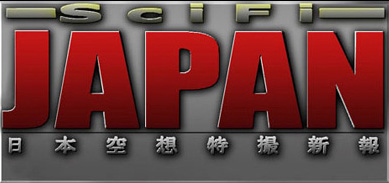
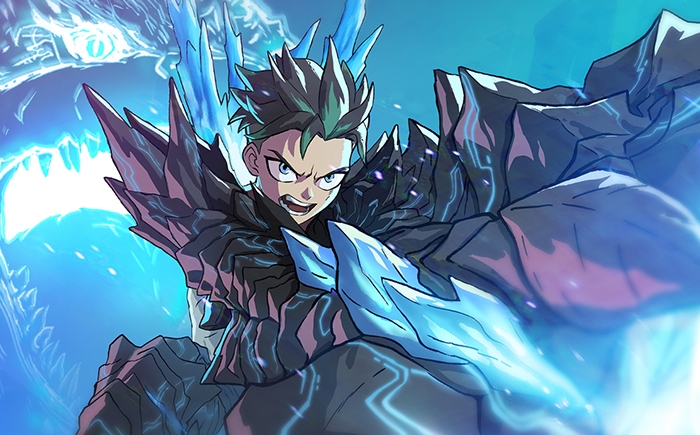
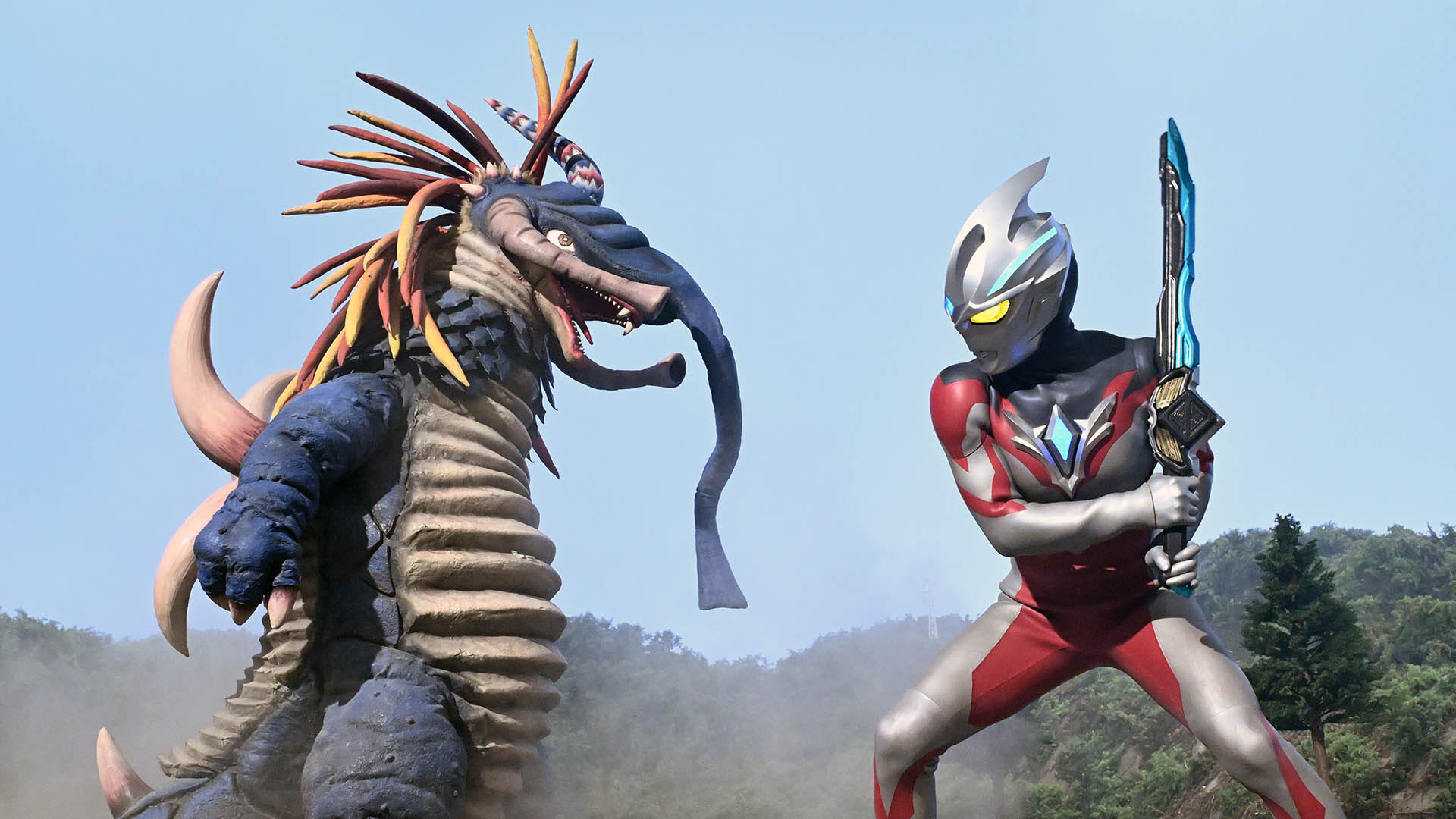
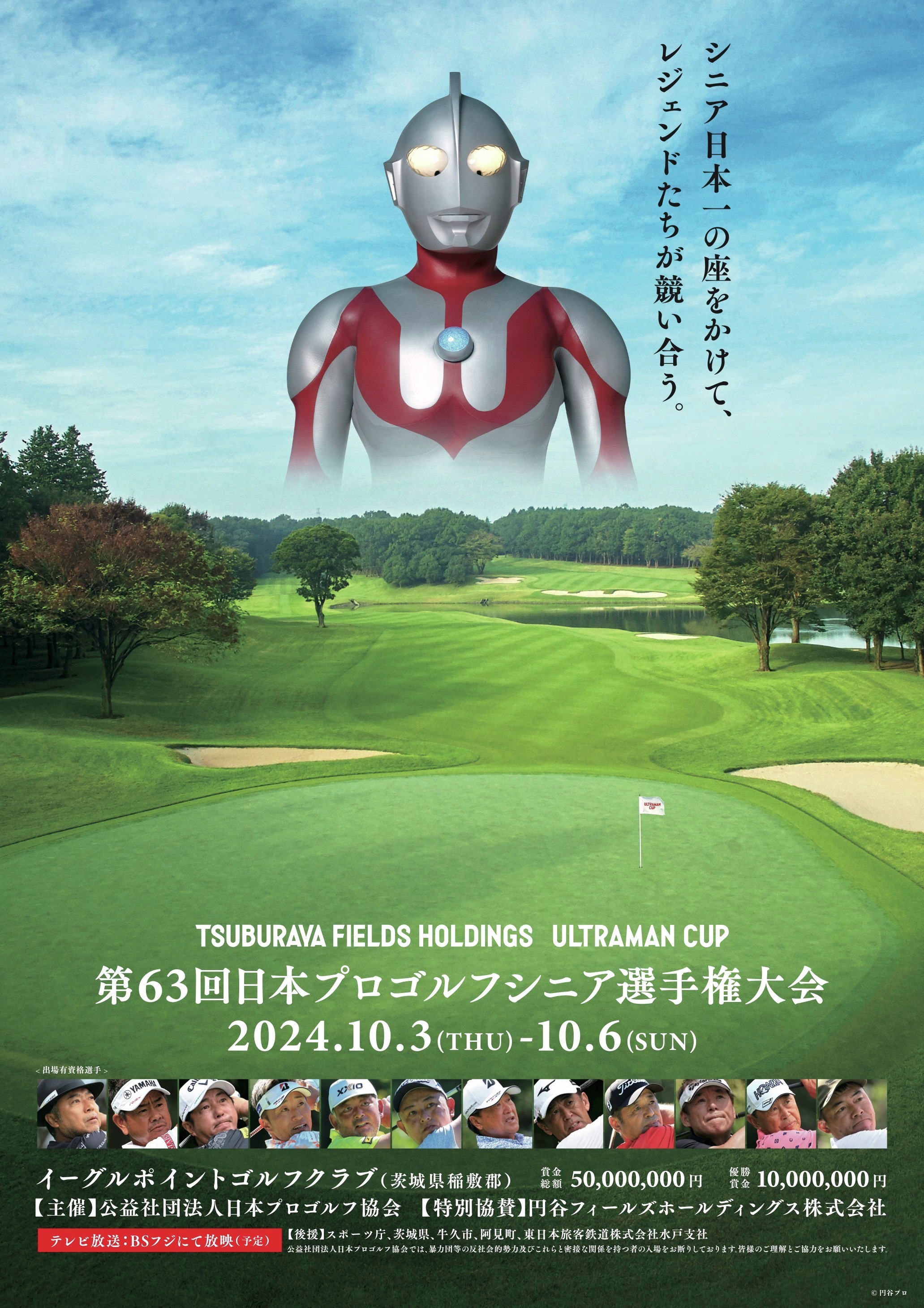
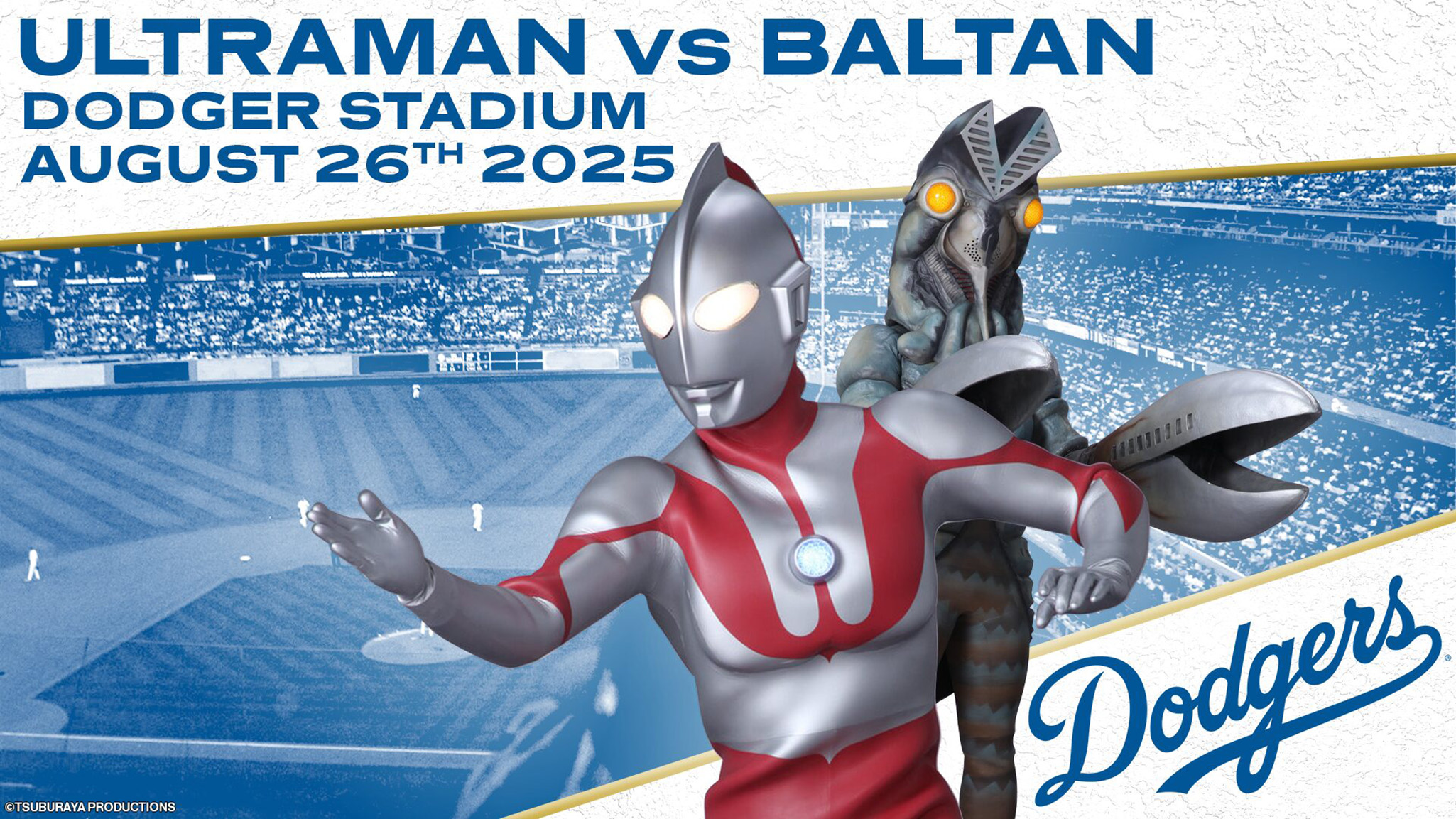
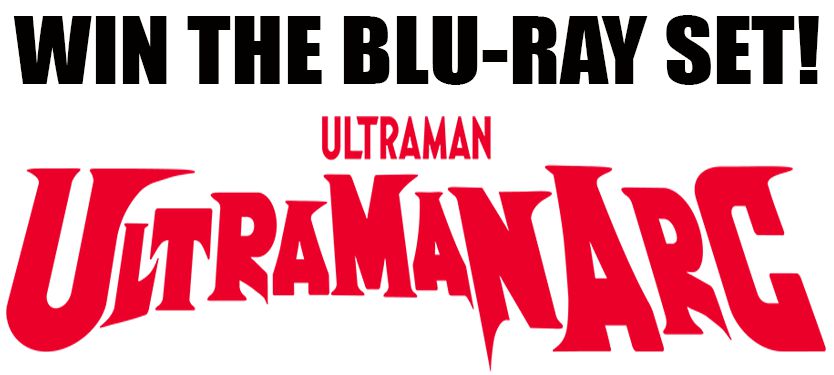
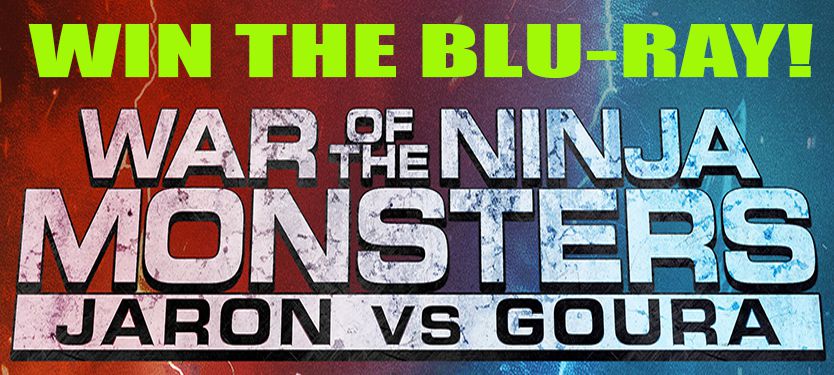









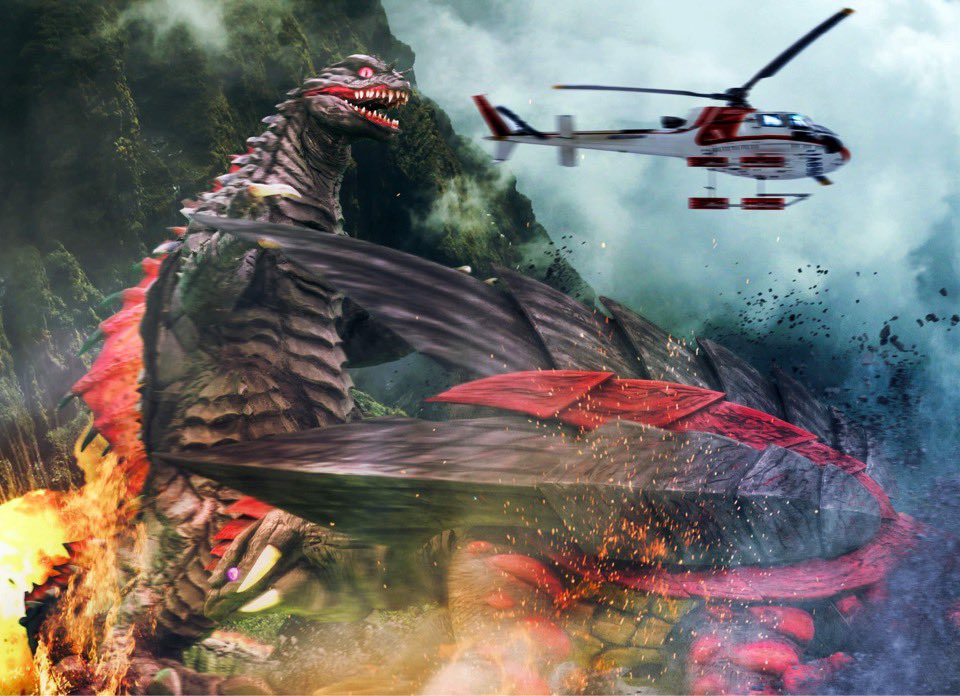
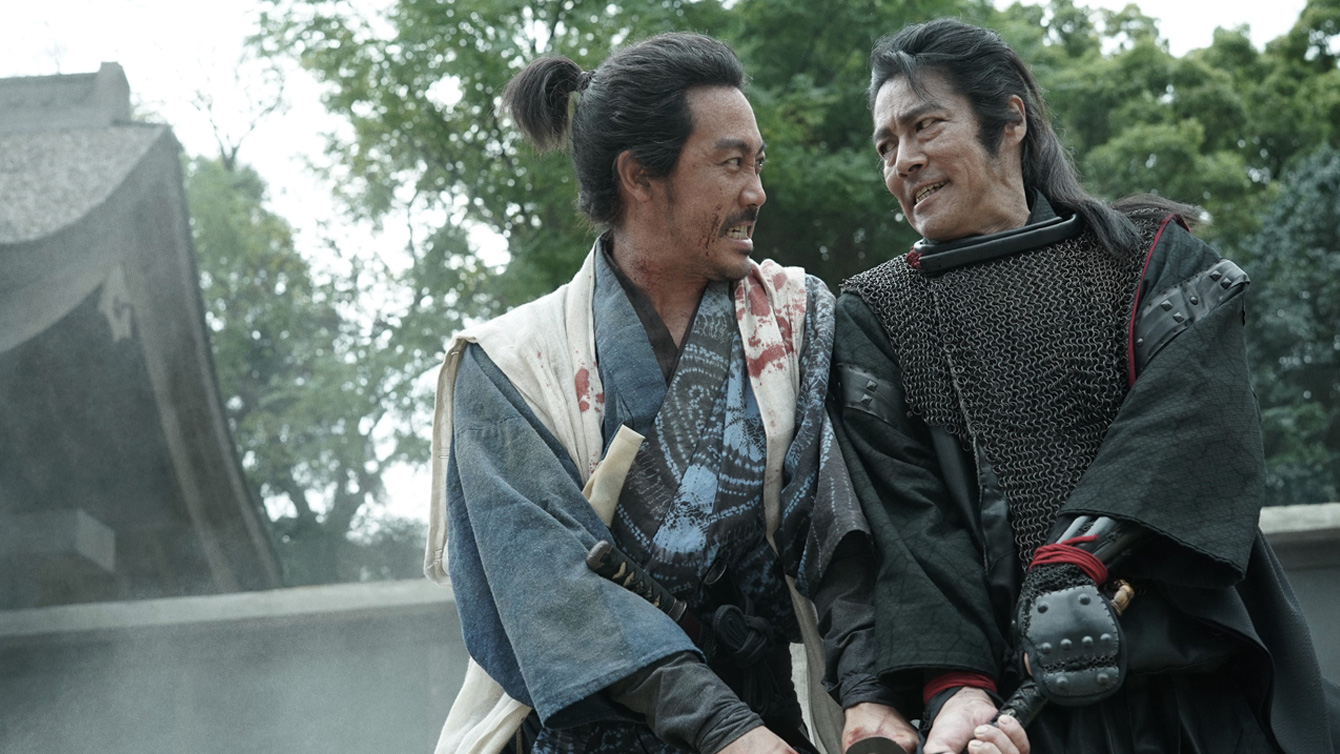
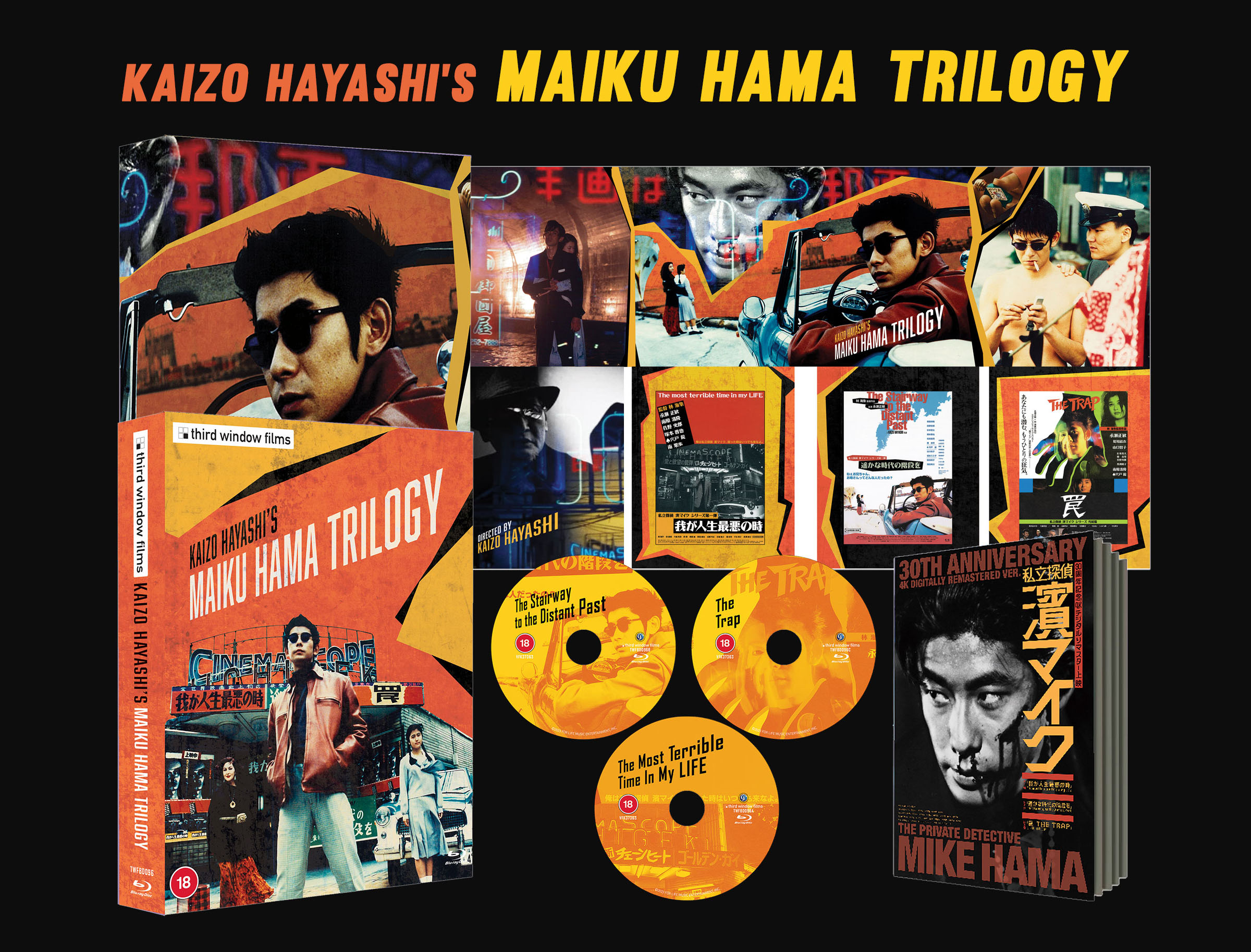

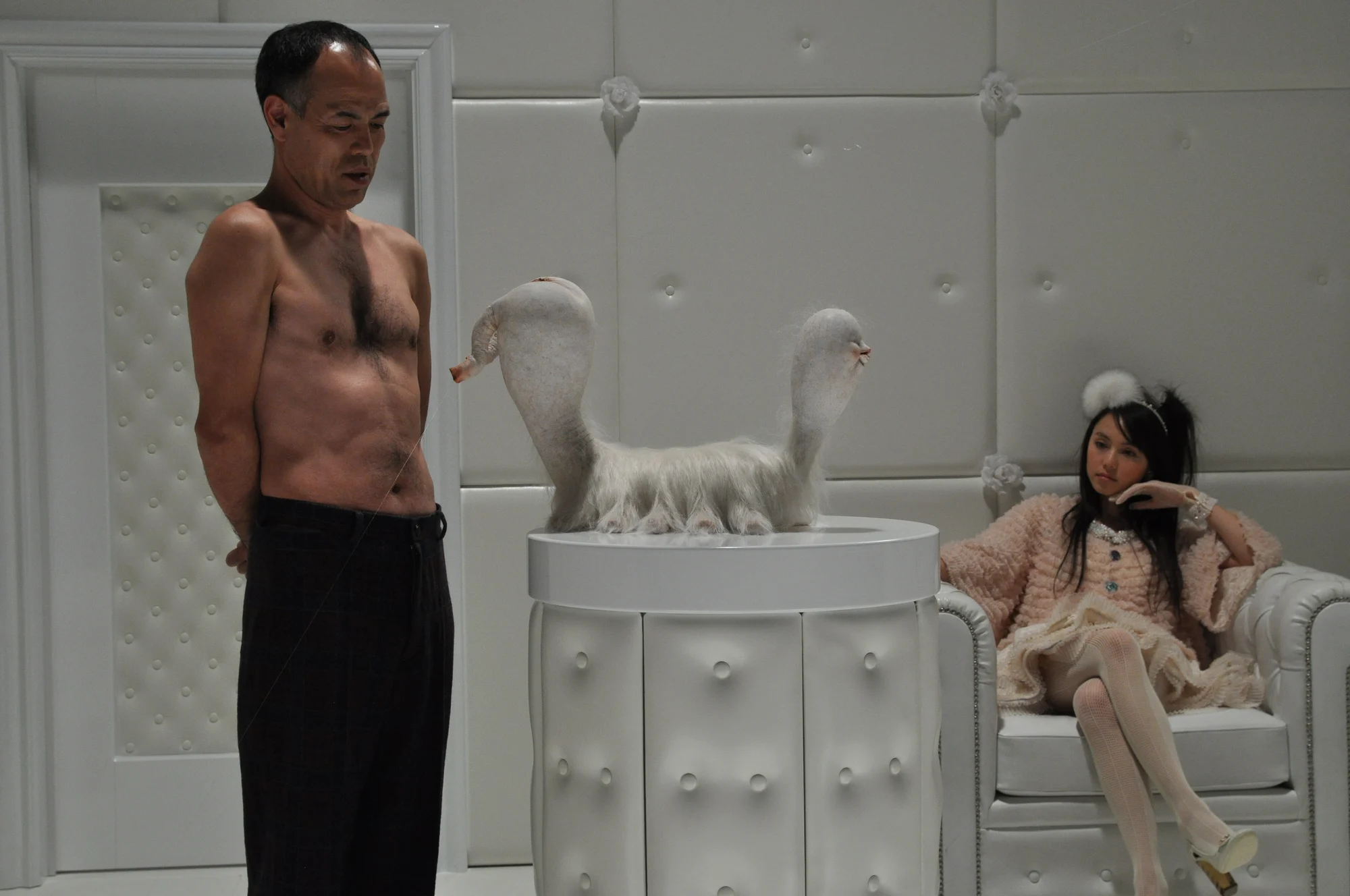
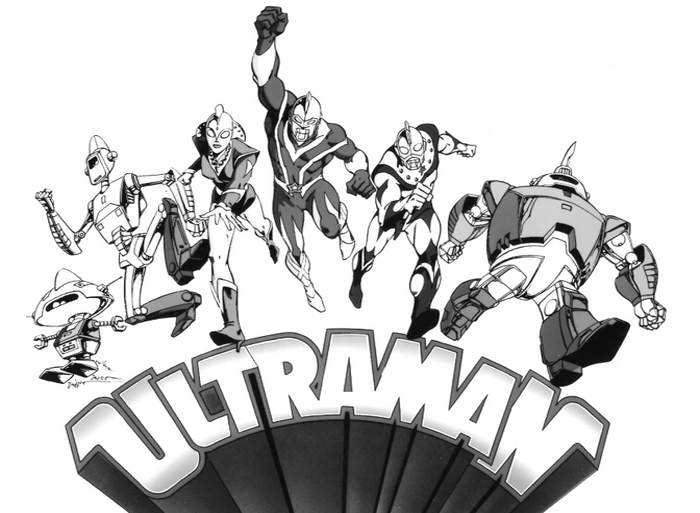 Publicity art for ULTRAMAN: THE ADVENTURE BEGINS depicting the Ultra Force team: Andy, Ulysses, Ultrawoman Beth, Ultraman Scott, Ultraman Chuck, and Samson. © 1987 Tsuburaya Productions Co., Ltd.
Publicity art for ULTRAMAN: THE ADVENTURE BEGINS depicting the Ultra Force team: Andy, Ulysses, Ultrawoman Beth, Ultraman Scott, Ultraman Chuck, and Samson. © 1987 Tsuburaya Productions Co., Ltd.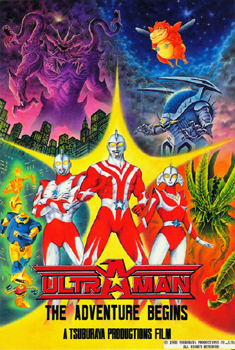 Tsuburaya Pro partnered with Hanna-Barbera for the animated film ULTRAMAN: THE ADVENTURE BEGINS, the first Ultraman production from America. © 1987 Tsuburaya Productions Co., Ltd.
Tsuburaya Pro partnered with Hanna-Barbera for the animated film ULTRAMAN: THE ADVENTURE BEGINS, the first Ultraman production from America. © 1987 Tsuburaya Productions Co., Ltd. ULTRAMAN: THE ADVENTURE BEGINS was theatrically released in Japan as ULTRAMAN USA. © 1987 Tsuburaya Productions Co., Ltd.
ULTRAMAN: THE ADVENTURE BEGINS was theatrically released in Japan as ULTRAMAN USA. © 1987 Tsuburaya Productions Co., Ltd. The first American Ultra Warriors... Ultrawoman Beth, Ultraman Scott, and Ultraman Chuck. © 1987 Tsuburaya Productions Co., Ltd.
The first American Ultra Warriors... Ultrawoman Beth, Ultraman Scott, and Ultraman Chuck. © 1987 Tsuburaya Productions Co., Ltd.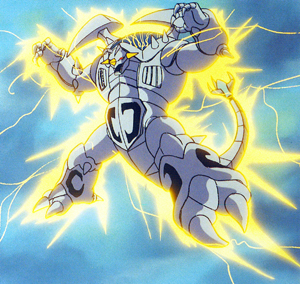 The electromagnetic monster Galbalard. © 1987 Tsuburaya Productions Co., Ltd.
The electromagnetic monster Galbalard. © 1987 Tsuburaya Productions Co., Ltd. King Maira, the most powerful of the Sorkin monsters, attacks New York. © 1987 Tsuburaya Productions Co., Ltd.
King Maira, the most powerful of the Sorkin monsters, attacks New York. © 1987 Tsuburaya Productions Co., Ltd. The Ultra Force robots Samson, Andy, and Ulysses work with Dr. Susan Rand. © 1987 Tsuburaya Productions Co., Ltd.
The Ultra Force robots Samson, Andy, and Ulysses work with Dr. Susan Rand. © 1987 Tsuburaya Productions Co., Ltd. Ultraman Chuck rescues the baby Sorkin monster Zoon. © 1987 Tsuburaya Productions Co., Ltd.
Ultraman Chuck rescues the baby Sorkin monster Zoon. © 1987 Tsuburaya Productions Co., Ltd. Ultrawoman Beth was voiced by Adrienne Barbeau. © 1987 Tsuburaya Productions Co., Ltd.
Ultrawoman Beth was voiced by Adrienne Barbeau. © 1987 Tsuburaya Productions Co., Ltd. Ultraman Scott bodychecks King Maira. © 1987 Tsuburaya Productions Co., Ltd.
Ultraman Scott bodychecks King Maira. © 1987 Tsuburaya Productions Co., Ltd. Scott stops by Mother Base for a visit. © 1987 Tsuburaya Productions Co., Ltd.
Scott stops by Mother Base for a visit. © 1987 Tsuburaya Productions Co., Ltd. Poster for the Ultraman Tournament featuring ULTRAMAN USA, selected episodes of ULTRAMAN and ULTRAMAN ACE, and an ULTRAMAN KIDS short. © 1987 Tsuburaya Productions Co., Ltd.
Poster for the Ultraman Tournament featuring ULTRAMAN USA, selected episodes of ULTRAMAN and ULTRAMAN ACE, and an ULTRAMAN KIDS short. © 1987 Tsuburaya Productions Co., Ltd. Hydra the dragon stalks the highways in a publicity still for the ULTRAMAN episode TERROR ON ROUTE 87. © 1966 Tsuburaya Productions Co., Ltd.
Hydra the dragon stalks the highways in a publicity still for the ULTRAMAN episode TERROR ON ROUTE 87. © 1966 Tsuburaya Productions Co., Ltd.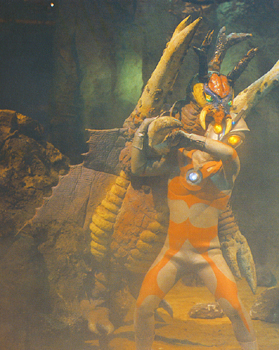 Ultraman Ace has his hands full with the subterranean monster Aribunta in GIANT ANT MONSTER VS THE ULTRA BROTHERS, part of a theatrical "Ultraman Festival" headlined by ULTRAMAN USA. © 1972 Tsuburaya Productions Co., Ltd.
Ultraman Ace has his hands full with the subterranean monster Aribunta in GIANT ANT MONSTER VS THE ULTRA BROTHERS, part of a theatrical "Ultraman Festival" headlined by ULTRAMAN USA. © 1972 Tsuburaya Productions Co., Ltd. Aribunta attacks a subway train. © 1972 Tsuburaya Productions Co., Ltd.
Aribunta attacks a subway train. © 1972 Tsuburaya Productions Co., Ltd.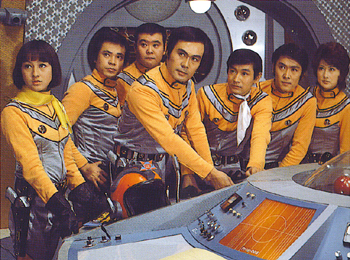 The members of TAC, the Terrible Monster Attacking Crew. © 1972 Tsuburaya Productions Co., Ltd.
The members of TAC, the Terrible Monster Attacking Crew. © 1972 Tsuburaya Productions Co., Ltd.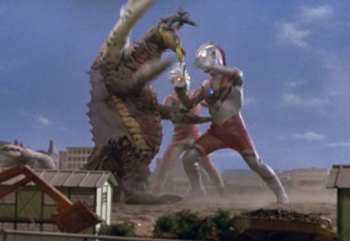 Ultraman Zoffy comes to Ace`s aid. © 1972 Tsuburaya Productions Co., Ltd.
Ultraman Zoffy comes to Ace`s aid. © 1972 Tsuburaya Productions Co., Ltd. The cast of ULTRAMAN KIDS. © 1986 Tsuburaya Productions Co., Ltd.
The cast of ULTRAMAN KIDS. © 1986 Tsuburaya Productions Co., Ltd. Nagira does what giant monsters do best in ULTRA Q THE MOVIE. © 1990 Tsuburaya-Eizo Co.
Nagira does what giant monsters do best in ULTRA Q THE MOVIE. © 1990 Tsuburaya-Eizo Co. The first Ultra Series returned in 1990 with ULTRA Q THE MOVIE. © 1990 Tsuburaya-Eizo Co.
The first Ultra Series returned in 1990 with ULTRA Q THE MOVIE. © 1990 Tsuburaya-Eizo Co. The movie incarnations of the classic ULTRA Q characters Ippei Togawa (Shingo Kazami), Yuriko Edogawa (Keiko Oginome), and Jun Manjome (Toshio Shiba). © 1990 Tsuburaya-Eizo Co.
The movie incarnations of the classic ULTRA Q characters Ippei Togawa (Shingo Kazami), Yuriko Edogawa (Keiko Oginome), and Jun Manjome (Toshio Shiba). © 1990 Tsuburaya-Eizo Co. Nagira takes out its anger at the desecration of an ancient burial site. © 1990 Tsuburaya-Eizo Co.
Nagira takes out its anger at the desecration of an ancient burial site. © 1990 Tsuburaya-Eizo Co. The murder investigation leads to the mysterious Mayumi Hoshino (Miyo Takagi). © 1990 Tsuburaya-Eizo Co.
The murder investigation leads to the mysterious Mayumi Hoshino (Miyo Takagi). © 1990 Tsuburaya-Eizo Co. Jun and Mayumi face off in the forest. © 1990 Tsuburaya-Eizo Co.
Jun and Mayumi face off in the forest. © 1990 Tsuburaya-Eizo Co. The onscreen title for the film. © 1990 Tsuburaya-Eizo Co.
The onscreen title for the film. © 1990 Tsuburaya-Eizo Co. Promotional art featuring the alien Wadatsujin and the monster Nagira. © 1990 Tsuburaya-Eizo Co.
Promotional art featuring the alien Wadatsujin and the monster Nagira. © 1990 Tsuburaya-Eizo Co. Ippei and Yuriko find one mystery piled on top of another. © 1990 Tsuburaya-Eizo Co.
Ippei and Yuriko find one mystery piled on top of another. © 1990 Tsuburaya-Eizo Co. "Movie star" Nagira: more valuable than an assistant director. © 1990 Tsuburaya-Eizo Co.
"Movie star" Nagira: more valuable than an assistant director. © 1990 Tsuburaya-Eizo Co. Mayumi Hoshino transforms into the alien lifeform Wadatsujin. © 1990 Tsuburaya-Eizo Co.
Mayumi Hoshino transforms into the alien lifeform Wadatsujin. © 1990 Tsuburaya-Eizo Co. The "cute" full-scale prop of Nagira`s foot. © 1990 Tsuburaya-Eizo Co.
The "cute" full-scale prop of Nagira`s foot. © 1990 Tsuburaya-Eizo Co. Mayumi and Jun make a connection on Ryu Island. © 1990 Tsuburaya-Eizo Co.
Mayumi and Jun make a connection on Ryu Island. © 1990 Tsuburaya-Eizo Co. The central characters Ippei Togawa (Shingo Kazami), Yuriko Edogawa (Keiko Oginome), Jun Manjome (Toshio Shiba), Mayumi Hoshino (Miyo Takagi), and Tetsushi Hamano (Masami Horiuchi) as seen through director Akio Jissoji`s trademark fish-eye lens. © 1990 Tsuburaya-Eizo Co.
The central characters Ippei Togawa (Shingo Kazami), Yuriko Edogawa (Keiko Oginome), Jun Manjome (Toshio Shiba), Mayumi Hoshino (Miyo Takagi), and Tetsushi Hamano (Masami Horiuchi) as seen through director Akio Jissoji`s trademark fish-eye lens. © 1990 Tsuburaya-Eizo Co. Colorized still of the giant monkey Goro from ULTRA Q: GORO AND GORO. © 1966 Tsuburaya Productions Co., Ltd.
Colorized still of the giant monkey Goro from ULTRA Q: GORO AND GORO. © 1966 Tsuburaya Productions Co., Ltd. Jun Manjome and Ippei Togawa search for their missing friend Yuriko Edogawa in a miniaturized city in a publicity still from ULTRA Q: THE 1/8 PROJECT. © 1966 Tsuburaya Productions Co., Ltd.
Jun Manjome and Ippei Togawa search for their missing friend Yuriko Edogawa in a miniaturized city in a publicity still from ULTRA Q: THE 1/8 PROJECT. © 1966 Tsuburaya Productions Co., Ltd.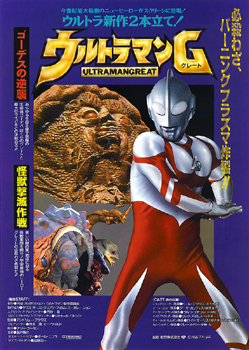 Poster for the two Ultraman Great compilation movies; THE ALIEN INVASION and THE BATTLE FOR EARTH. © 1990 Ultraman Production Committee
Poster for the two Ultraman Great compilation movies; THE ALIEN INVASION and THE BATTLE FOR EARTH. © 1990 Ultraman Production Committee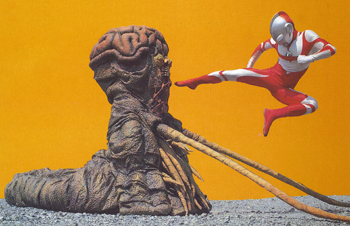 The space monster Goudis battles Ultraman Great on Mars. © 1990 Ultraman Production Committee
The space monster Goudis battles Ultraman Great on Mars. © 1990 Ultraman Production Committee Ultraman Great`s human alter ego; Jack Shindo (Dore Kraus). © 1990 Ultraman Production Committee
Ultraman Great`s human alter ego; Jack Shindo (Dore Kraus). © 1990 Ultraman Production Committee ULTRAMAN: THE ALIEN INVASION was released on VHS in Britain. © 1990 Ultraman Production Committee
ULTRAMAN: THE ALIEN INVASION was released on VHS in Britain. © 1990 Ultraman Production Committee Onscreen title for the film. © 1990 Ultraman Production Committee
Onscreen title for the film. © 1990 Ultraman Production Committee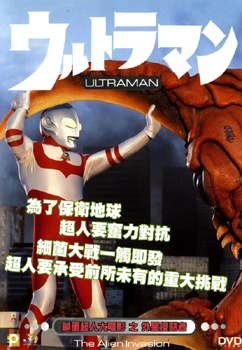 The Hong Kong DVD of ULTRAMAN: THE ALIEN INVASION includes the original English audio track plus English subtitles. © 1990 Ultraman Production Committee
The Hong Kong DVD of ULTRAMAN: THE ALIEN INVASION includes the original English audio track plus English subtitles. © 1990 Ultraman Production Committee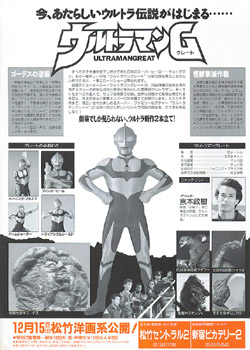 Advertisement for ULTRAMAN: THE ALIEN INVASION and ULTRAMAN: THE BATTLE FOR EARTH. © 1990 Ultraman Production Committee
Advertisement for ULTRAMAN: THE ALIEN INVASION and ULTRAMAN: THE BATTLE FOR EARTH. © 1990 Ultraman Production Committee Ultraman Great tries to bring a halt to Rugulo`s rampage. © 1990 Ultraman Production Committee
Ultraman Great tries to bring a halt to Rugulo`s rampage. © 1990 Ultraman Production Committee Onscreen title for the film. © 1990 Ultraman Production Committee
Onscreen title for the film. © 1990 Ultraman Production Committee Ultraman Great battles Kudara. © 1990 Ultraman Production Committee
Ultraman Great battles Kudara. © 1990 Ultraman Production Committee Shillagee. © 1990 Ultraman Production Committee
Shillagee. © 1990 Ultraman Production Committee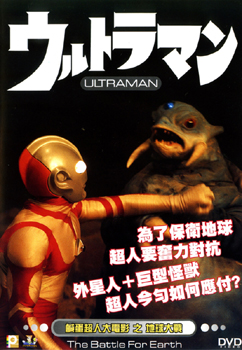 Cover art for the Hong Kong DVD of ULTRAMAN: THE BATTLE FOR EARTH. The disc includes the original English audio track. © 1990 Ultraman Production Committee
Cover art for the Hong Kong DVD of ULTRAMAN: THE BATTLE FOR EARTH. The disc includes the original English audio track. © 1990 Ultraman Production Committee English language title card for THE WONDERFUL WORLD OF ULTRAMAN. © 1996 Tsuburaya Productions Co., Ltd., Sony Pictures and Music Entertainment, Dentsu
English language title card for THE WONDERFUL WORLD OF ULTRAMAN. © 1996 Tsuburaya Productions Co., Ltd., Sony Pictures and Music Entertainment, Dentsu TPC celebrated the 30th anniversary of Ultraman with the new movie THE WONDERFUL WORLD OF ULTRAMAN. © 1996 Tsuburaya Productions Co., Ltd., Sony Pictures and Music Entertainment, Dentsu
TPC celebrated the 30th anniversary of Ultraman with the new movie THE WONDERFUL WORLD OF ULTRAMAN. © 1996 Tsuburaya Productions Co., Ltd., Sony Pictures and Music Entertainment, Dentsu Promo art for the three segments of THE WONDERFUL WORLD OF ULTRAMAN. © 1996 Tsuburaya Productions Co., Ltd., Sony Pictures and Music Entertainment, Dentsu
Promo art for the three segments of THE WONDERFUL WORLD OF ULTRAMAN. © 1996 Tsuburaya Productions Co., Ltd., Sony Pictures and Music Entertainment, Dentsu The stock footage of ULTRAMAN FOREVER was spruced up with some computer graphics such as a more colorful Specium Ray for Ultraman. © 1996 Tsuburaya Productions Co., Ltd., Sony Pictures and Music Entertainment, Dentsu
The stock footage of ULTRAMAN FOREVER was spruced up with some computer graphics such as a more colorful Specium Ray for Ultraman. © 1996 Tsuburaya Productions Co., Ltd., Sony Pictures and Music Entertainment, Dentsu A classic publicity shot from the ULTRAMAN series was reused in the promotional campaign for ULTRAMAN FOREVER. © 1966 Tsuburaya Productions Co., Ltd.
A classic publicity shot from the ULTRAMAN series was reused in the promotional campaign for ULTRAMAN FOREVER. © 1966 Tsuburaya Productions Co., Ltd.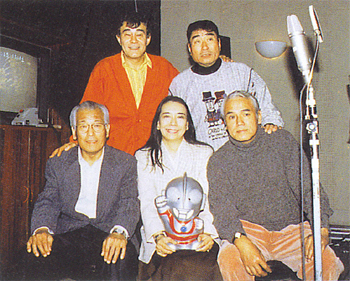 The original cast of ULTRAMAN reunited for the final time to record the new voice track for ULTRAMAN FOREVER. Standing: Masanari Nihei (Ide), Sandaiyu Dokumamushi (Arashi). Seated: Akiji Kobayashi (Muramatsu), Hiroko Sakurai (Fuji), Susumu Kurobe (Hayata). © 1996 Tsuburaya Productions Co., Ltd., Sony Pictures and Music Entertainment, Dentsu
The original cast of ULTRAMAN reunited for the final time to record the new voice track for ULTRAMAN FOREVER. Standing: Masanari Nihei (Ide), Sandaiyu Dokumamushi (Arashi). Seated: Akiji Kobayashi (Muramatsu), Hiroko Sakurai (Fuji), Susumu Kurobe (Hayata). © 1996 Tsuburaya Productions Co., Ltd., Sony Pictures and Music Entertainment, Dentsu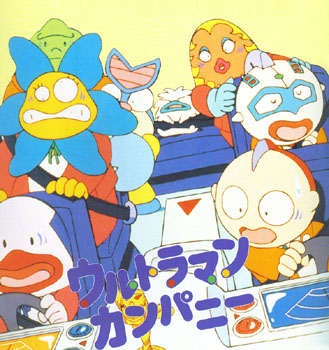 The Ultra characters are portrayed as salarymen in the animated short ULTRAMAN COMPANY. © 1996 Tsuburaya Productions Co., Ltd., Sony Pictures and Music Entertainment, Dentsu
The Ultra characters are portrayed as salarymen in the animated short ULTRAMAN COMPANY. © 1996 Tsuburaya Productions Co., Ltd., Sony Pictures and Music Entertainment, Dentsu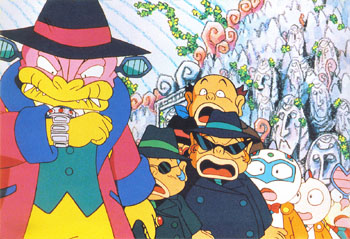 The Ultraman Company team must contend with monster gangsters led by Dr Yango and Boss Gann. © 1996 Tsuburaya Productions Co., Ltd., Sony Pictures and Music Entertainment, Dentsu
The Ultraman Company team must contend with monster gangsters led by Dr Yango and Boss Gann. © 1996 Tsuburaya Productions Co., Ltd., Sony Pictures and Music Entertainment, Dentsu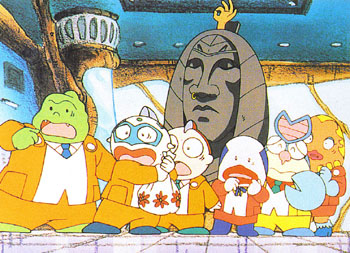 Mr. Rekkin, CEO Seven, Ultra-kun, Dadako, Balta-kun, and Metro-chan find themselves in one jam after another as they attempt to recover the stolen Moya Moya Statue. © 1996 Tsuburaya Productions Co., Ltd., Sony Pictures and Music Entertainment, Dentsu
Mr. Rekkin, CEO Seven, Ultra-kun, Dadako, Balta-kun, and Metro-chan find themselves in one jam after another as they attempt to recover the stolen Moya Moya Statue. © 1996 Tsuburaya Productions Co., Ltd., Sony Pictures and Music Entertainment, Dentsu ULTRAMAN ZEARTH was the third segment of WONDERFUL WORLD OF ULTRAMAN. © 1996 Tsuburaya Productions Co., Ltd., Sony Pictures and Music Entertainment, Dentsu
ULTRAMAN ZEARTH was the third segment of WONDERFUL WORLD OF ULTRAMAN. © 1996 Tsuburaya Productions Co., Ltd., Sony Pictures and Music Entertainment, Dentsu A statue of Ultraman is one of the first gold items to mysteriously disappear. © 1996 Tsuburaya Productions Co., Ltd., Sony Pictures and Music Entertainment, Dentsu
A statue of Ultraman is one of the first gold items to mysteriously disappear. © 1996 Tsuburaya Productions Co., Ltd., Sony Pictures and Music Entertainment, Dentsu Zearth attacks Cottenpoppeh. © 1996 Tsuburaya Productions Co., Ltd., Sony Pictures and Music Entertainment, Dentsu
Zearth attacks Cottenpoppeh. © 1996 Tsuburaya Productions Co., Ltd., Sony Pictures and Music Entertainment, Dentsu Katsuto Asahi (Masaharu Sekiguchi) uses his electric toothbrush to change into Ultraman Zearth. © 1996 Tsuburaya Productions Co., Ltd., Sony Pictures and Music Entertainment, Dentsu
Katsuto Asahi (Masaharu Sekiguchi) uses his electric toothbrush to change into Ultraman Zearth. © 1996 Tsuburaya Productions Co., Ltd., Sony Pictures and Music Entertainment, Dentsu With his red face and body design, Zearth had a look different from previous Ultramen. © 1996 Tsuburaya Productions Co., Ltd., Sony Pictures and Music Entertainment, Dentsu
With his red face and body design, Zearth had a look different from previous Ultramen. © 1996 Tsuburaya Productions Co., Ltd., Sony Pictures and Music Entertainment, Dentsu MYDO trainee Katsuto Asahi is harassed by his superior officers. © 1996 Tsuburaya Productions Co., Ltd., Sony Pictures and Music Entertainment, Dentsu
MYDO trainee Katsuto Asahi is harassed by his superior officers. © 1996 Tsuburaya Productions Co., Ltd., Sony Pictures and Music Entertainment, Dentsu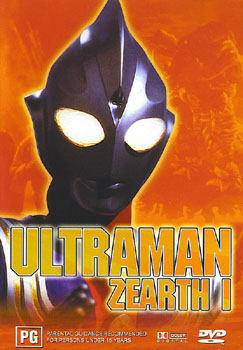 Ultraman Tiga hogs the spotlight on the Australian DVD cover for ULTRAMAN ZEARTH. © 1996 Tsuburaya Productions Co., Ltd., Sony Pictures and Music Entertainment, Dentsu
Ultraman Tiga hogs the spotlight on the Australian DVD cover for ULTRAMAN ZEARTH. © 1996 Tsuburaya Productions Co., Ltd., Sony Pictures and Music Entertainment, Dentsu Ultraman Shadow guards the base of alien invader Lady Benzen. © 1997 Tsuburaya Productions Co., Ltd., Sony Music Entertainment, Dentsu
Ultraman Shadow guards the base of alien invader Lady Benzen. © 1997 Tsuburaya Productions Co., Ltd., Sony Music Entertainment, Dentsu Japanese theatrical poster for ULTRAMAN ZEARTH 2. © 1997 Tsuburaya Productions Co., Ltd., Sony Music Entertainment, Dentsu
Japanese theatrical poster for ULTRAMAN ZEARTH 2. © 1997 Tsuburaya Productions Co., Ltd., Sony Music Entertainment, Dentsu Zearth`s capsule monster Miraclon gets punched in the face by Shadow. © 1997 Tsuburaya Productions Co., Ltd., Sony Music Entertainment, Dentsu
Zearth`s capsule monster Miraclon gets punched in the face by Shadow. © 1997 Tsuburaya Productions Co., Ltd., Sony Music Entertainment, Dentsu Ultraman Zearth battles Ultraman Shadow on Shadow Island. © 1997 Tsuburaya Productions Co., Ltd., Sony Music Entertainment, Dentsu
Ultraman Zearth battles Ultraman Shadow on Shadow Island. © 1997 Tsuburaya Productions Co., Ltd., Sony Music Entertainment, Dentsu Katsuto Asahi becomes Ultraman Zearth. © 1997 Tsuburaya Productions Co., Ltd., Sony Music Entertainment, Dentsu
Katsuto Asahi becomes Ultraman Zearth. © 1997 Tsuburaya Productions Co., Ltd., Sony Music Entertainment, Dentsu Ultraman Shadow`s capsule monster Darklar lands on Miraclon. © 1997 Tsuburaya Productions Co., Ltd., Sony Music Entertainment, Dentsu
Ultraman Shadow`s capsule monster Darklar lands on Miraclon. © 1997 Tsuburaya Productions Co., Ltd., Sony Music Entertainment, Dentsu ULTRAMAN`s Susumu Kurobe plays an average guy who thinks his spoon is a Beta Capsule. © 1997 Tsuburaya Productions Co., Ltd., Sony Music Entertainment, Dentsu
ULTRAMAN`s Susumu Kurobe plays an average guy who thinks his spoon is a Beta Capsule. © 1997 Tsuburaya Productions Co., Ltd., Sony Music Entertainment, Dentsu Tiga steals Zearth`s thunder once again. ULTRAMAN ZEARTH 2 Australian DVD cover art. © 1997 Tsuburaya Productions Co., Ltd., Sony Music Entertainment, Dentsu
Tiga steals Zearth`s thunder once again. ULTRAMAN ZEARTH 2 Australian DVD cover art. © 1997 Tsuburaya Productions Co., Ltd., Sony Music Entertainment, Dentsu Paired with ULTRAMAN ZEARTH 2 was ULTRA MEOW, an animated short about a super cat from outer space. © 1997 1997 Tsuburaya Productions Co., Ltd., Sony Music Entertainment, Dentsu
Paired with ULTRAMAN ZEARTH 2 was ULTRA MEOW, an animated short about a super cat from outer space. © 1997 1997 Tsuburaya Productions Co., Ltd., Sony Music Entertainment, Dentsu The space cat Nyan finds both trouble and kindness on Earth. © 1997 Tsuburaya Productions Co., Ltd., Sony Music Entertainment, Dentsu
The space cat Nyan finds both trouble and kindness on Earth. © 1997 Tsuburaya Productions Co., Ltd., Sony Music Entertainment, Dentsu Nyan is captured by the catnapper Inugami. © 1997 Tsuburaya Productions Co., Ltd., Sony Music Entertainment, Dentsu
Nyan is captured by the catnapper Inugami. © 1997 Tsuburaya Productions Co., Ltd., Sony Music Entertainment, Dentsu Final character design for Ultra Meow. © 1997 Tsuburaya Productions Co., Ltd., Sony Music Entertainment, Dentsu
Final character design for Ultra Meow. © 1997 Tsuburaya Productions Co., Ltd., Sony Music Entertainment, Dentsu Haruka and Ultra Meow. © 1997 Tsuburaya Productions Co., Ltd., Sony Music Entertainment, Dentsu
Haruka and Ultra Meow. © 1997 Tsuburaya Productions Co., Ltd., Sony Music Entertainment, Dentsu